Take me there.
[Click on the Full Screen icon in the lower right corner to best appreciate the video]
Take me there.
[Click on the Full Screen icon in the lower right corner to best appreciate the video]
My daughter and her partner are building a Tiny House from the ground up in Nehalem, Oregon. My contribution is a pocket door for the bathroom. For this project I selected some rough sawn, old-growth, clear vertical grain (CVG) Douglas fir that I had been hoarding for 30 years for the door frame and panels. [Click on any image to enlarge, All photos ![]() Max Vollmer]
Max Vollmer]
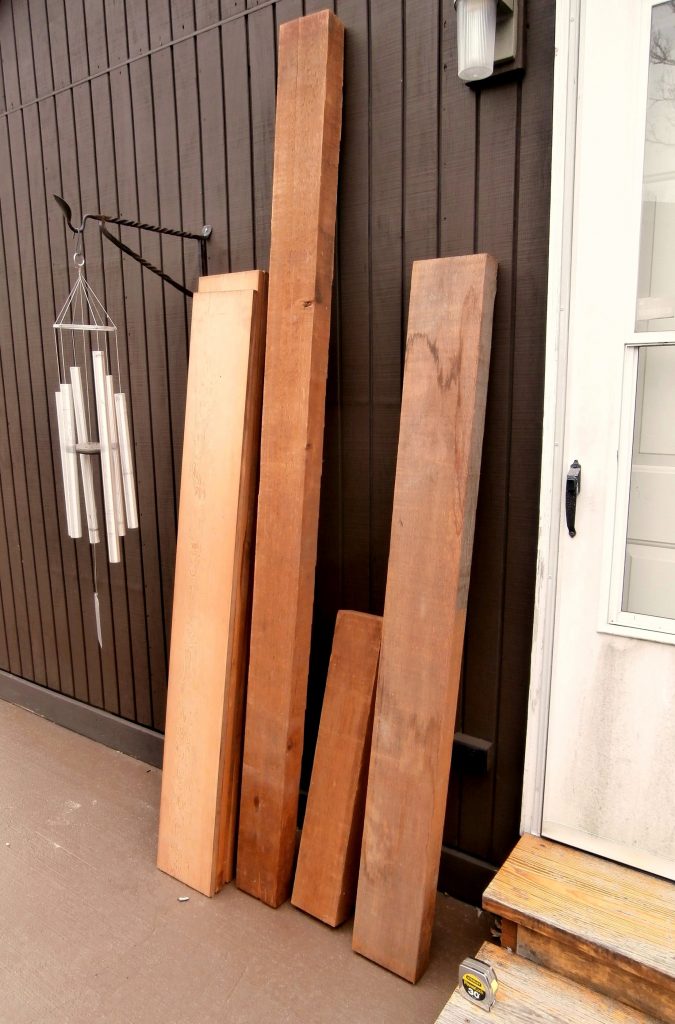
The first step was to size and plane the lumber according to my plan and cut list for a six-panel door with a stained glass mosaic visible from one side only. Then I cut the mortises and tenons for the door frame and dry-fit the pieces. It is absolutely critical for a door that the frame be dead-square, with 90 degree angles at all joints.

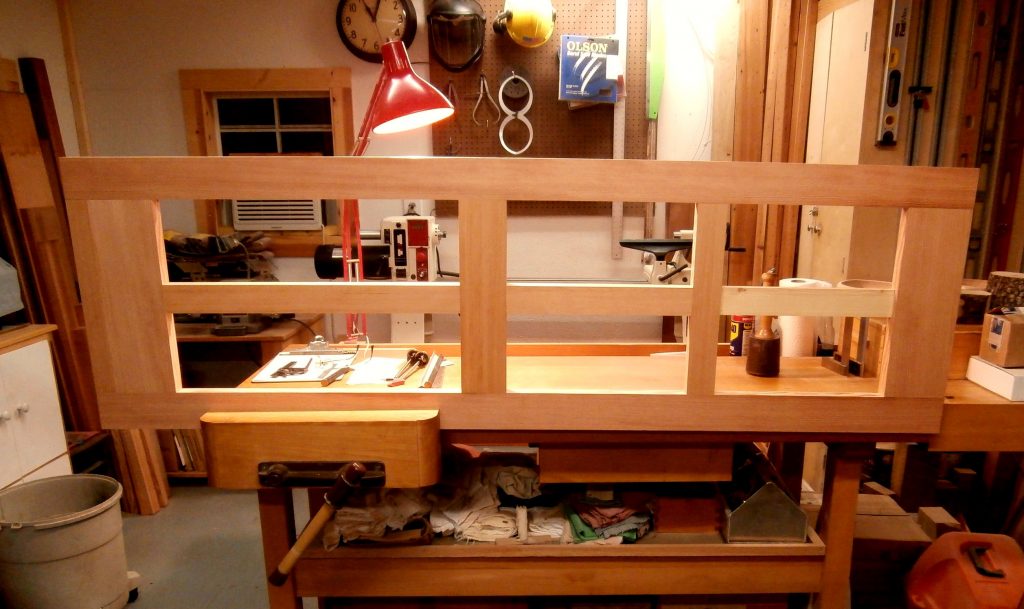
The next step was to cut the rabbets all around the inside of the frame members to accept the 3/4 inch thick panels. As with any frame and panel construction, allowance has to be made for the expansion-contraction of solid wood panels that occurs with changes in ambient humidity.
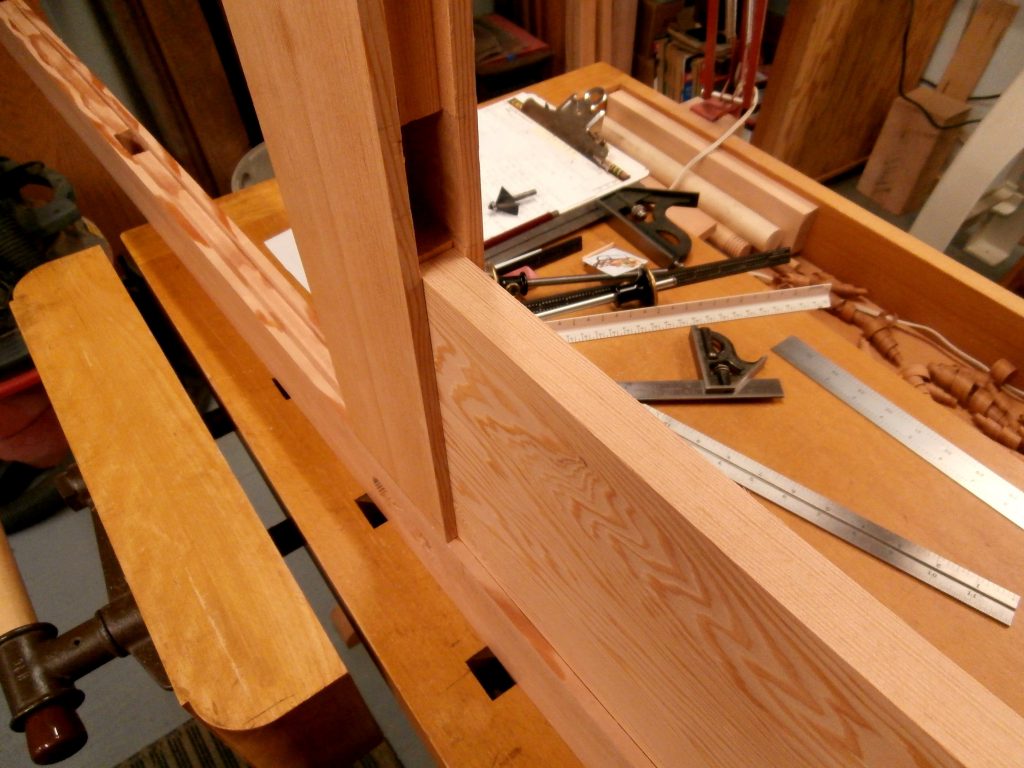
With the door frame members sized, the mortises and tenons cut, and the panels sized, I now had a door “kit” ready for embellishment, sanding, and assembly.
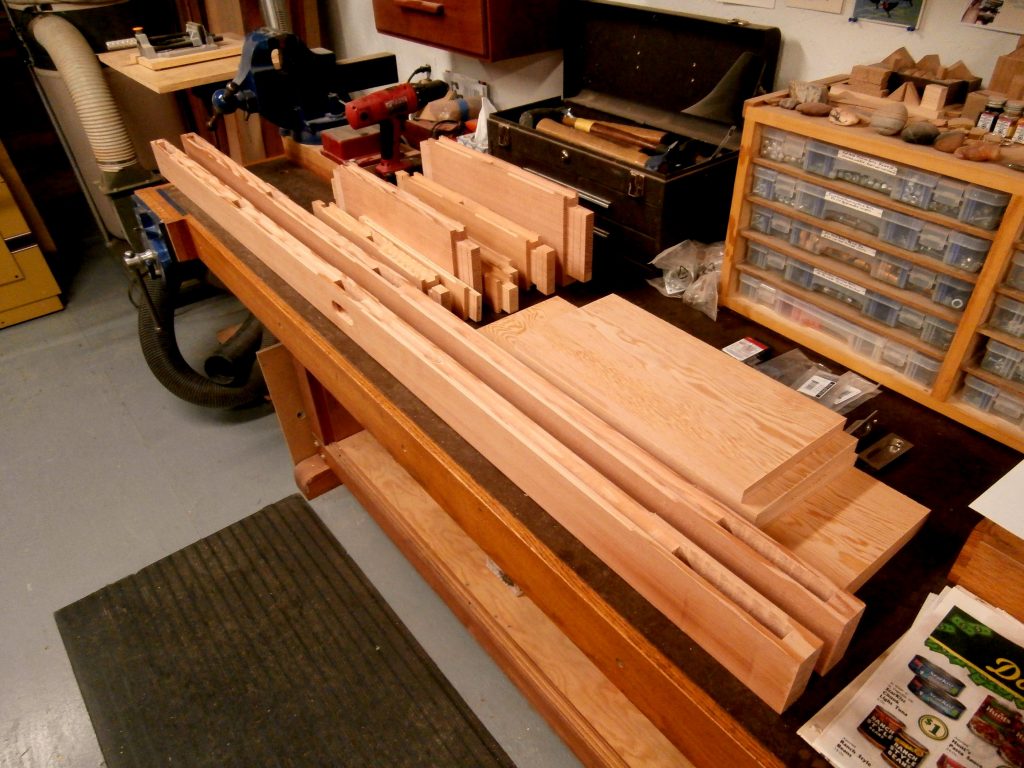
To add a little interest, I created 45 degree, stop-chamfers around all framed openings in the door on both sides.

The side of the door that faces out was planned with a stained glass mosaic depicting a cormorant perched on a piling in the surf, a common sight on the Oregon coast. The hand crafted mosaic was glued down to a 1/4 inch thick masonite panel sized to fit the door frame.
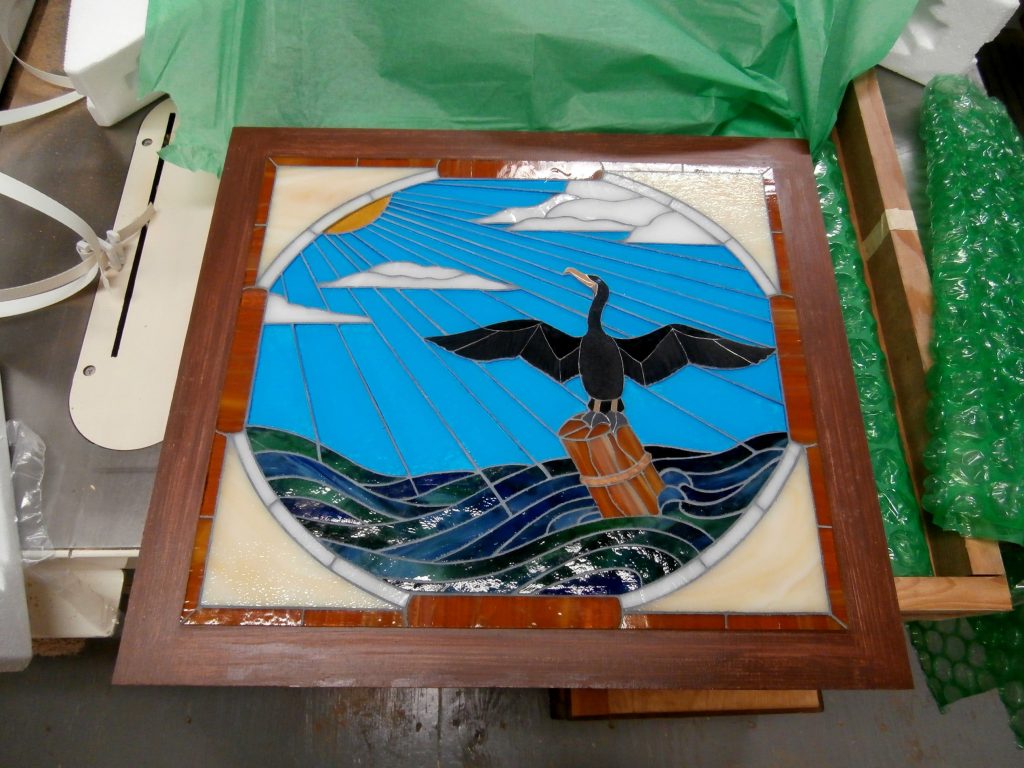
My plan called for the stained glass mosaic to be recessed 1/4 inch in from the front surface of the door frame and “picture-framed” with thin, beveled pieces of fir. Then backing up the mosaic, and on the back side of the door, I cut and planed thin but solid fir panels to make it appear as a six-panel wood door on the reverse side.
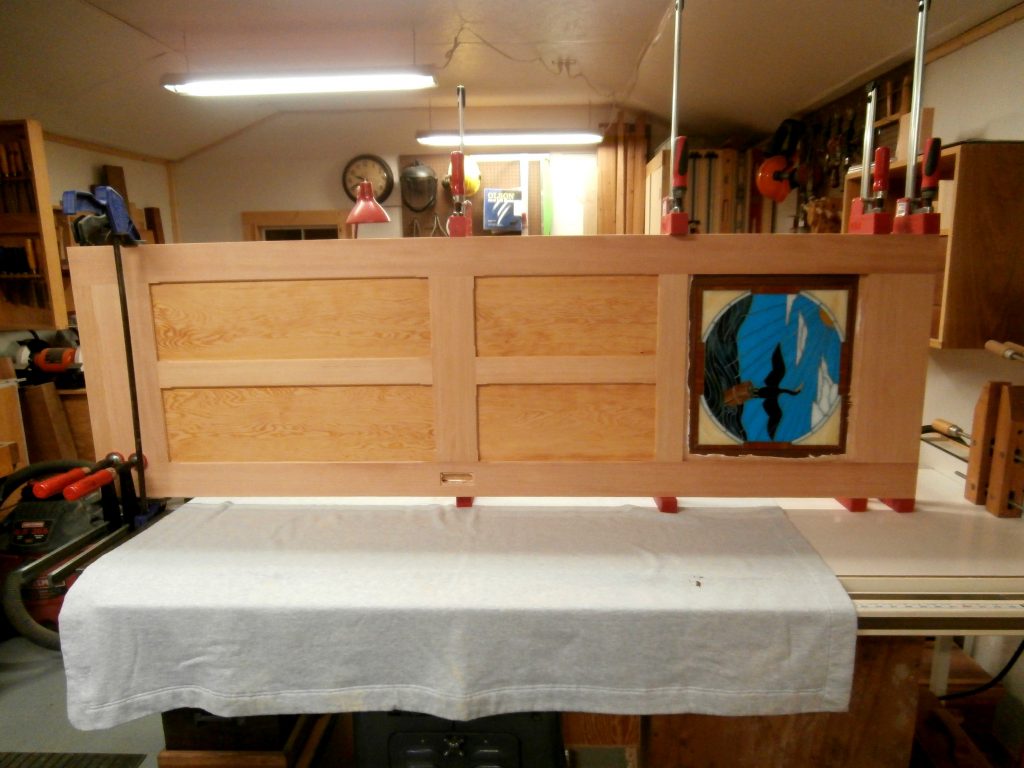
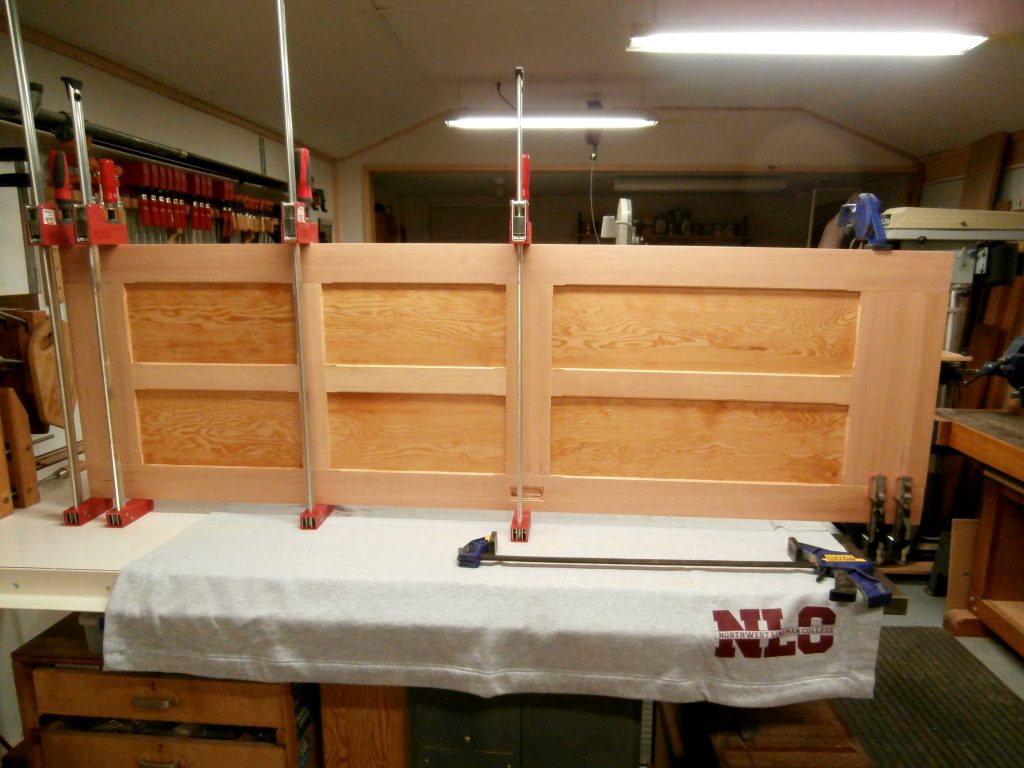
Because this is a pocket door and will slide into a cavity in the wall rather than be hung from hinges, I used door pulls that were inset flush with the door surface, instead of regular door knob hardware. To retrieve the door from the pocket when it is open, I used an edge pull inset into the door frame. Finally, we wanted to employ a rare-earth magnet catch to hold the door closed and you can see one-half of that magnetic catch installed above the edge pull.
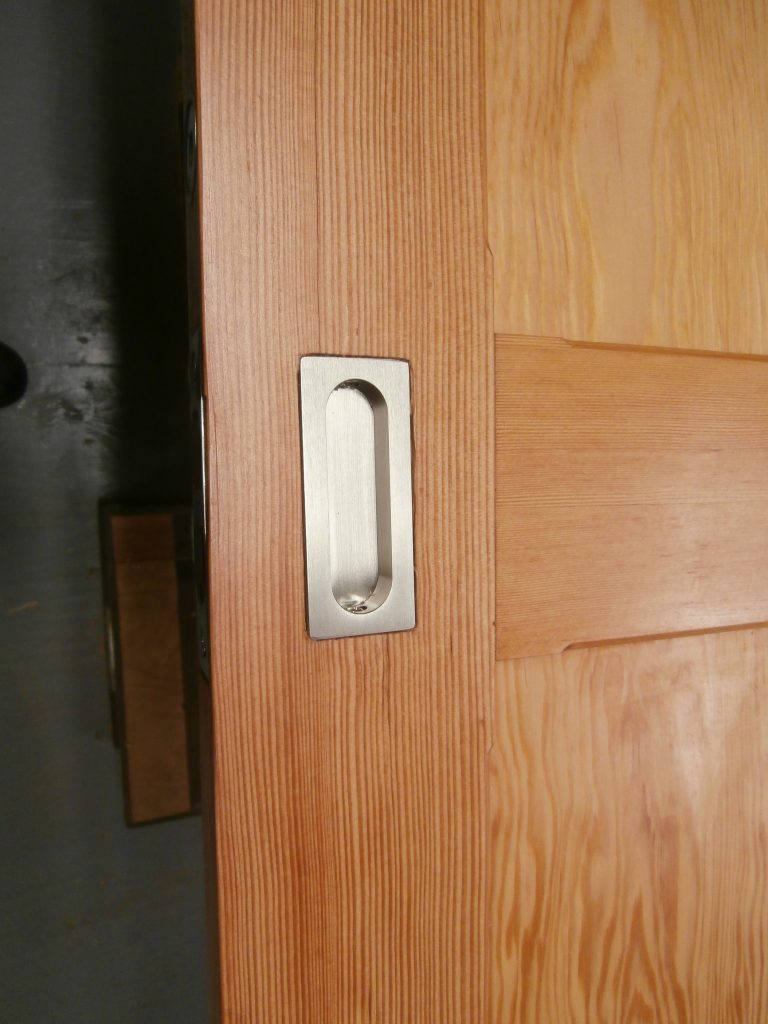
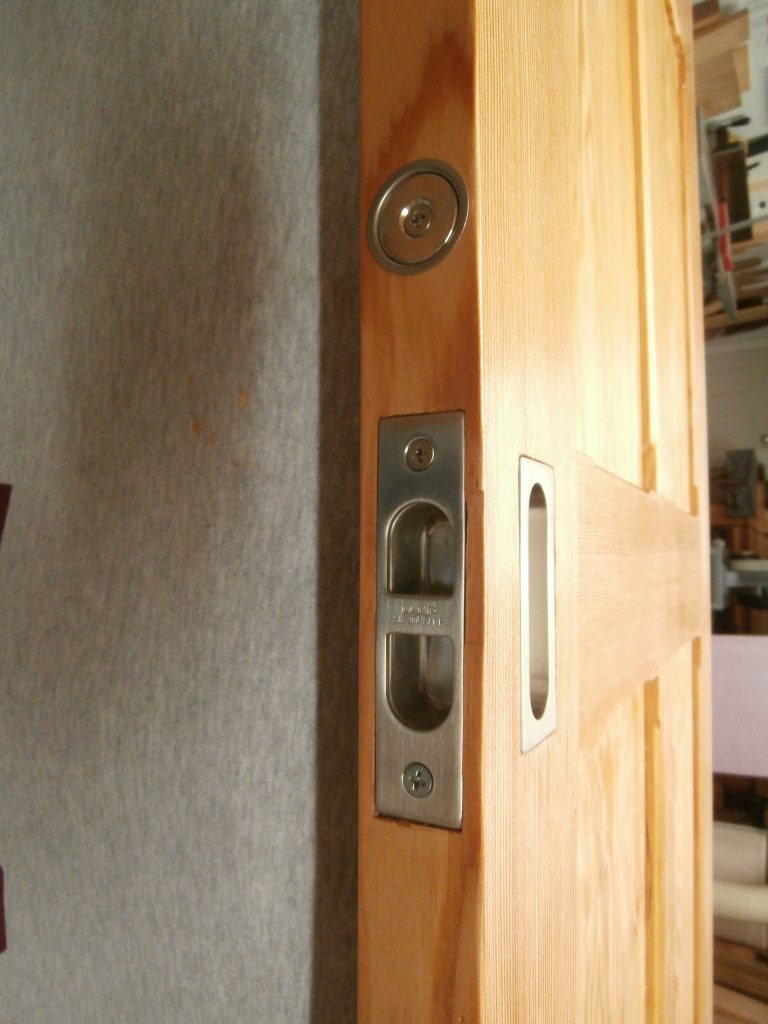
Although the framing members were glued at the mortise and tenon joints, I built in extra stability and longevity by pinning the four corners of the frame with 1/2 inch cherry dowels that are visible only from the back side of the door.

I signed the door on the bottom edge of the back side with my “makers mark.”
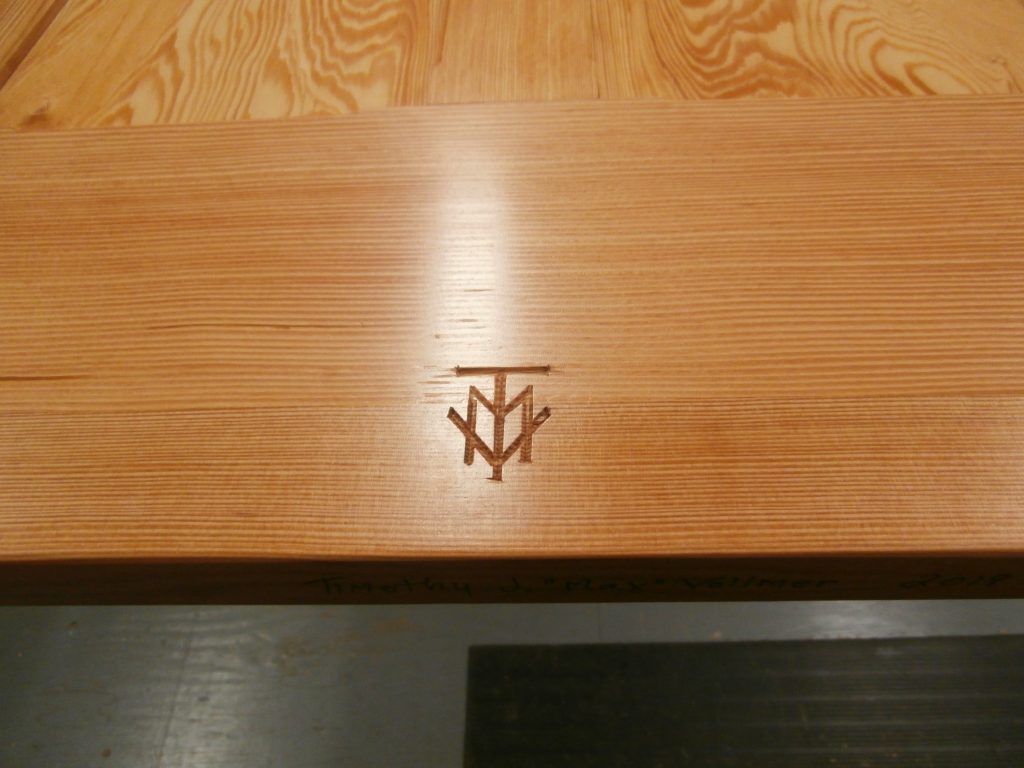
Here are photos of the finished door, front and back, in my shop.
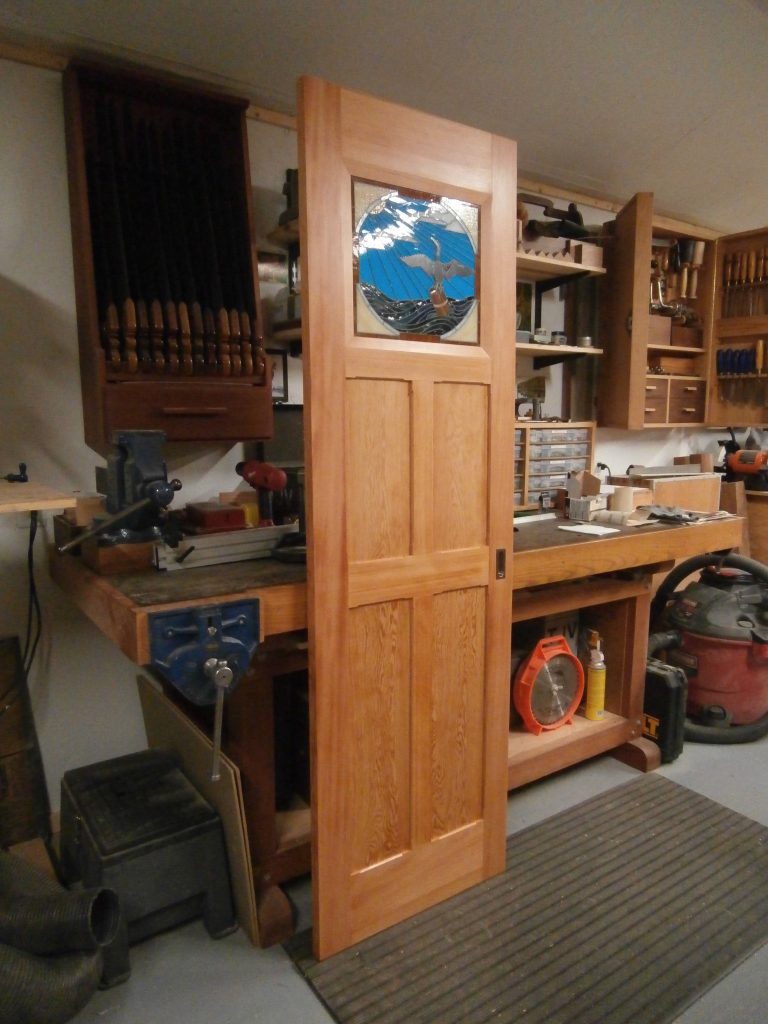
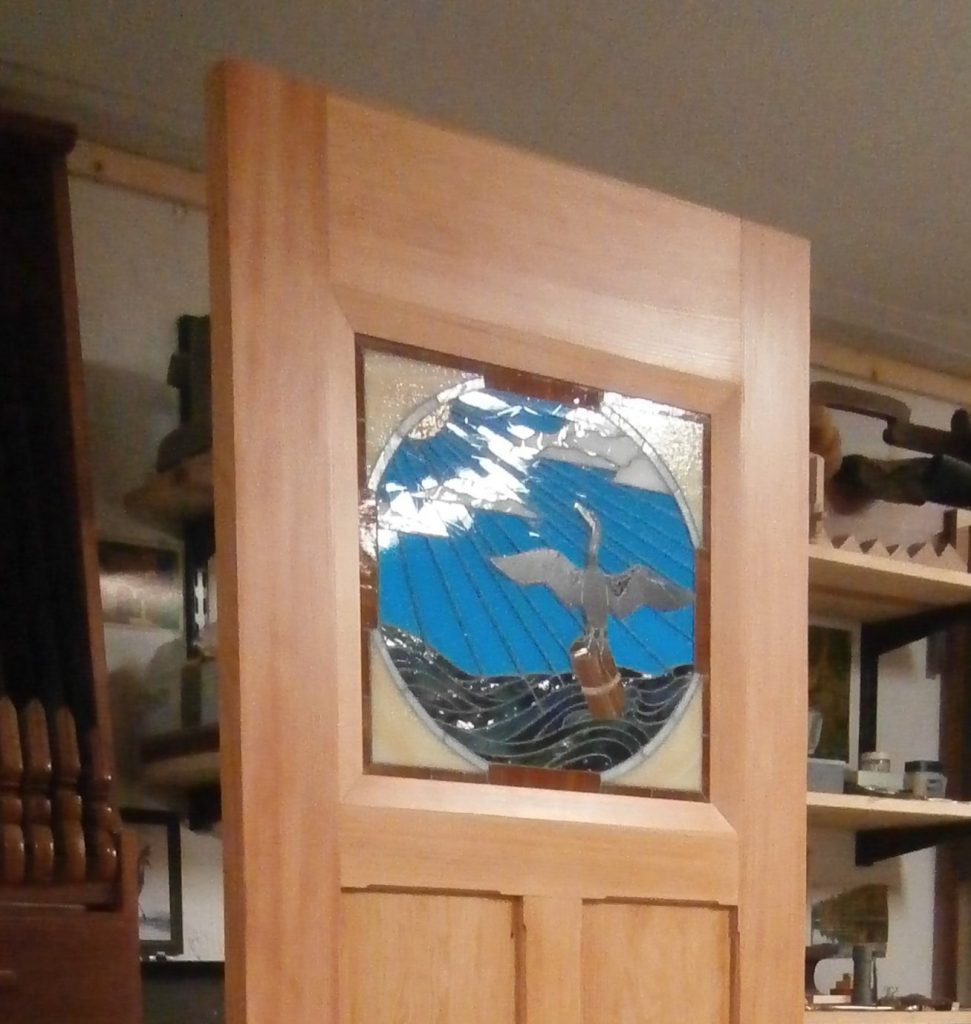
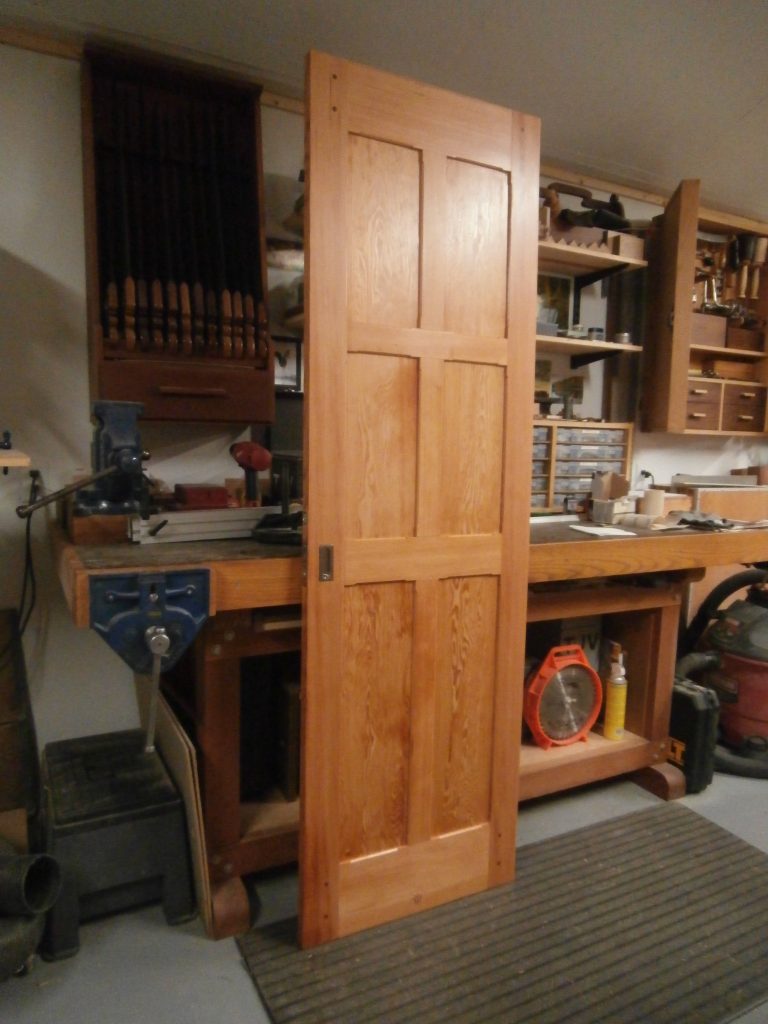
Proudly built in Canada by Canadian shipbuilders!
Actually ‘splitting wood’ more accurately describes what I do each winter in order to maintain a two year supply of cured firewood for my woodstove. [All photos ![]() Max Vollmer, Click on any photo to enlarge. ]
Max Vollmer, Click on any photo to enlarge. ]
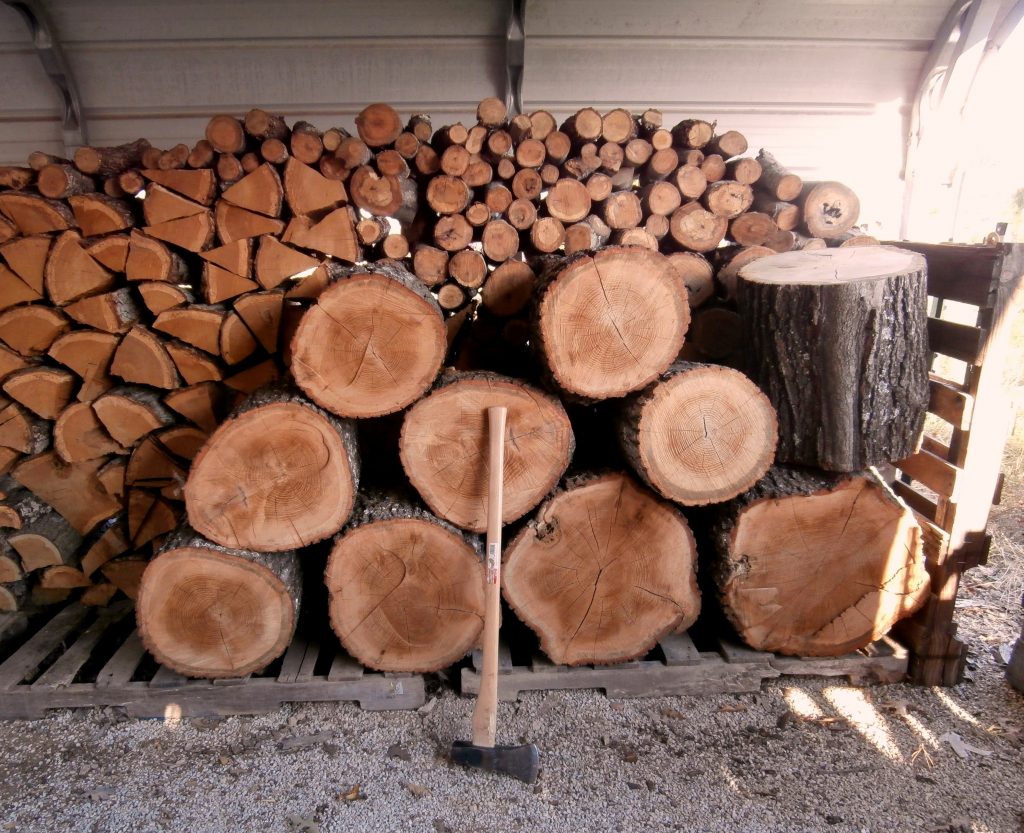
A year ago I felled a red oak tree on my property that had succumbed to a pest locally referred to as the ‘green ash borer.’ The base of the tree was a little over 24 inches in diameter and I cut the bolts (log sections) into approx. 24 inch lengths to fit my cast iron, airtight stove from Ireland. I let these bolts sit all summer to begin to dry and then in the Fall I split them into sections left to dry another year. I fell trees and split firewood when the days are cold to avoid breaking a sweat. Temperatures in the low to mid-40’s Fahrenheit are perfect for splitting, while temperatures in the mid-30’s are better for felling and bucking.
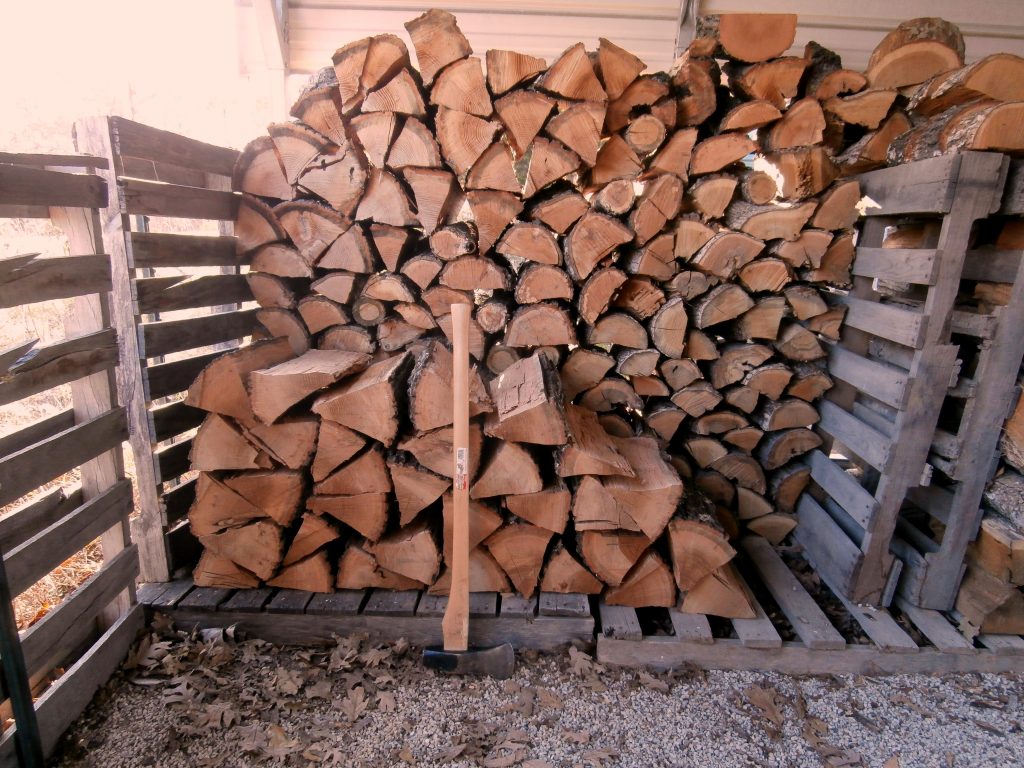
I’ve been splitting firewood since I was 11 or 12 years old. As a kid I used a Plumb ax to split wood for the family fireplace. For the last 40 years I’ve been using a maul which is much more efficient! Currently I am using an 8 lb. maul which is needed for these large oak rounds. When I bought my current property it came with a gas-powered log splitter that I used for one season. It was fast, but I sold it because I prefer to split the wood by hand. It’s naturally much harder work by hand, but it is part of what keeps me in shape at 73. Through the years of using a heavy maul, I’ve learned how to put biomechanics to work for me. I’ve perfected something like a full overhead, figure-8 swing that employs gravity, momentum, a pendulum motion, and centripetal force to do the work. My arms and arm muscles don’t really do the work of splitting, so much as they direct the mechanical motion and application of force (mass x acceleration = force) that does.
I made this small, wall mounted cabinet to hold my layout tools for measuring and marking. It puts them within easy reach and keeps them organized. I used some off-cuts of red oak, black cherry, American elm, and sugar maple that were too good to throw away. And I used some of the same tools that are now housed in the cabinet to make it. [All photos ![]() Max Vollmer, Click on any photo to enlarge]
Max Vollmer, Click on any photo to enlarge]
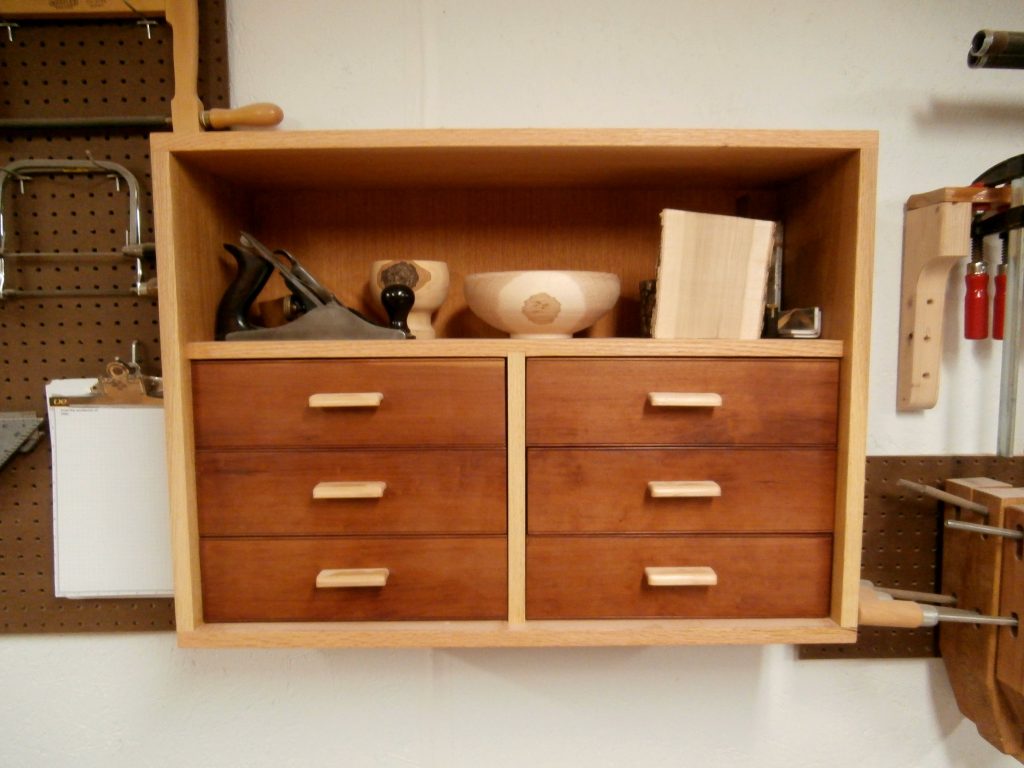
Step one: having determined the dimensions for the cabinet and cut the component pieces to size, I started the through dovetails for the case by marking the length for the tails based on the thickness of the board to which they will be joined, using an adjustable marking gauge made by Veritas Tools in Canada.
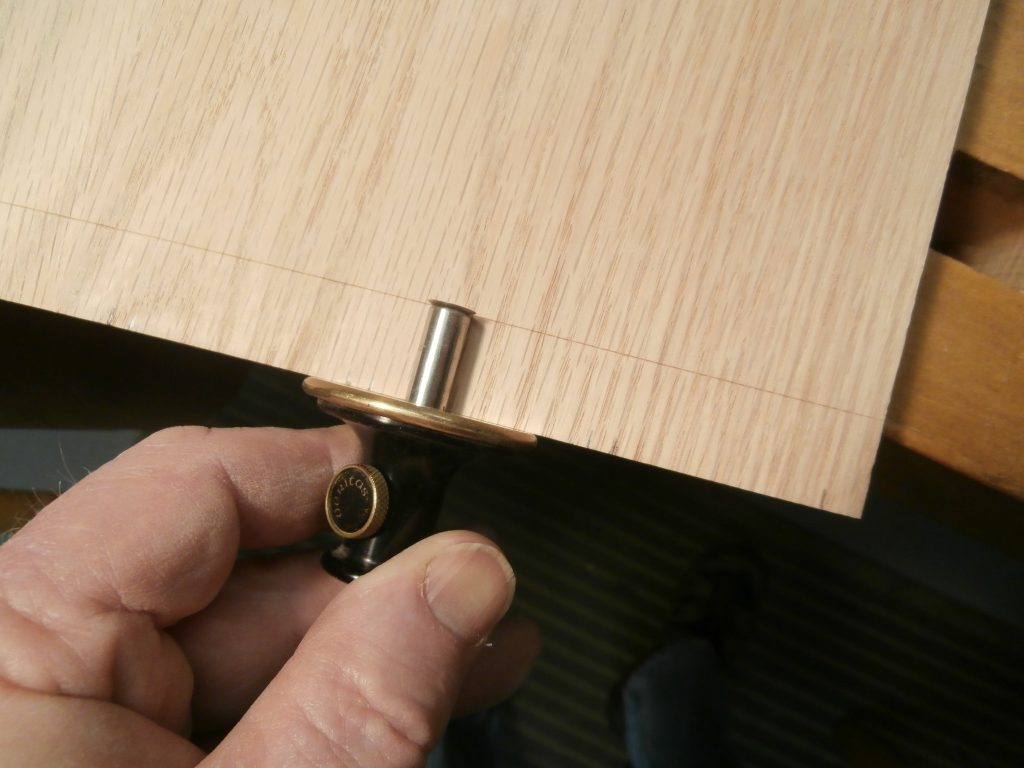
Having decided on my dovetail spacing, I then marked the tails with a brass dovetail guide made by an Englishman, Richard Kell, many years ago.
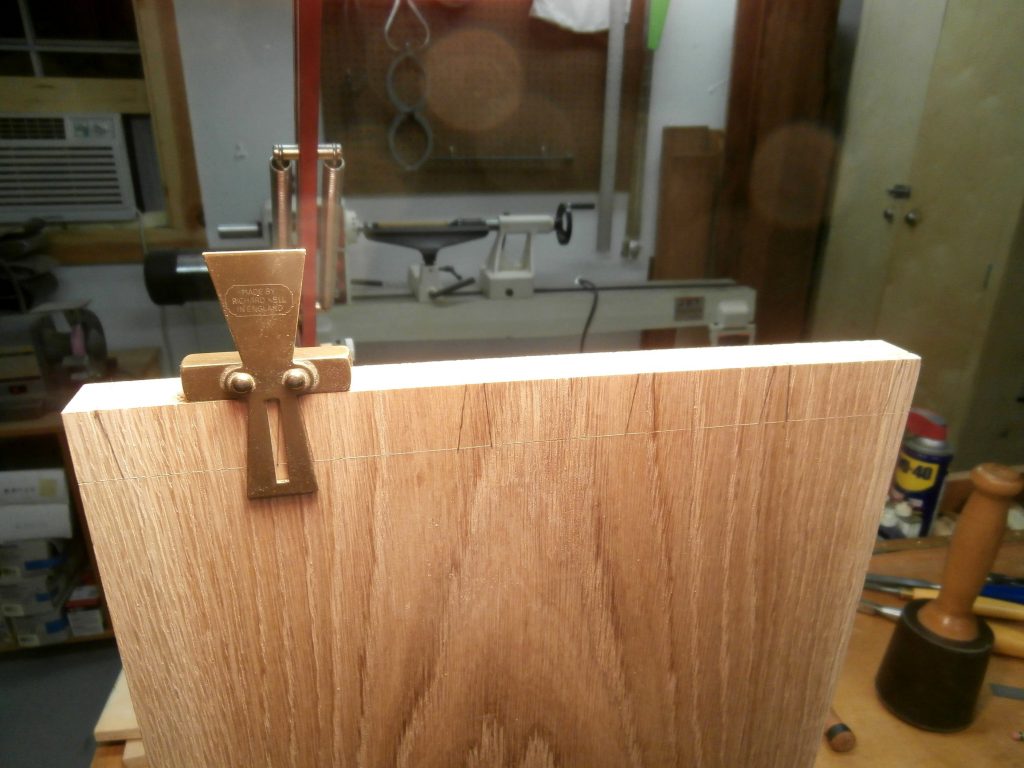
The next two steps were to cut alongside the marked tails and then chop out the waste between them.

To align the dovetails with matching pins, I clamped the board with the finished tails in my bench vise and lined up the board that will have pins and marked their location. With the spacing marked in pencil, I used a marking knife to inscribe the outlines of the waste between pins. I go to all this trouble to get the narrowest pins and finest fit. There are always slight variations in hand cut dovetails, unlike those made with a router and jig. It is not possible to get the very small pins you see in fine, antique furniture with a router and I want my furniture to reflect the skill required for hand work.
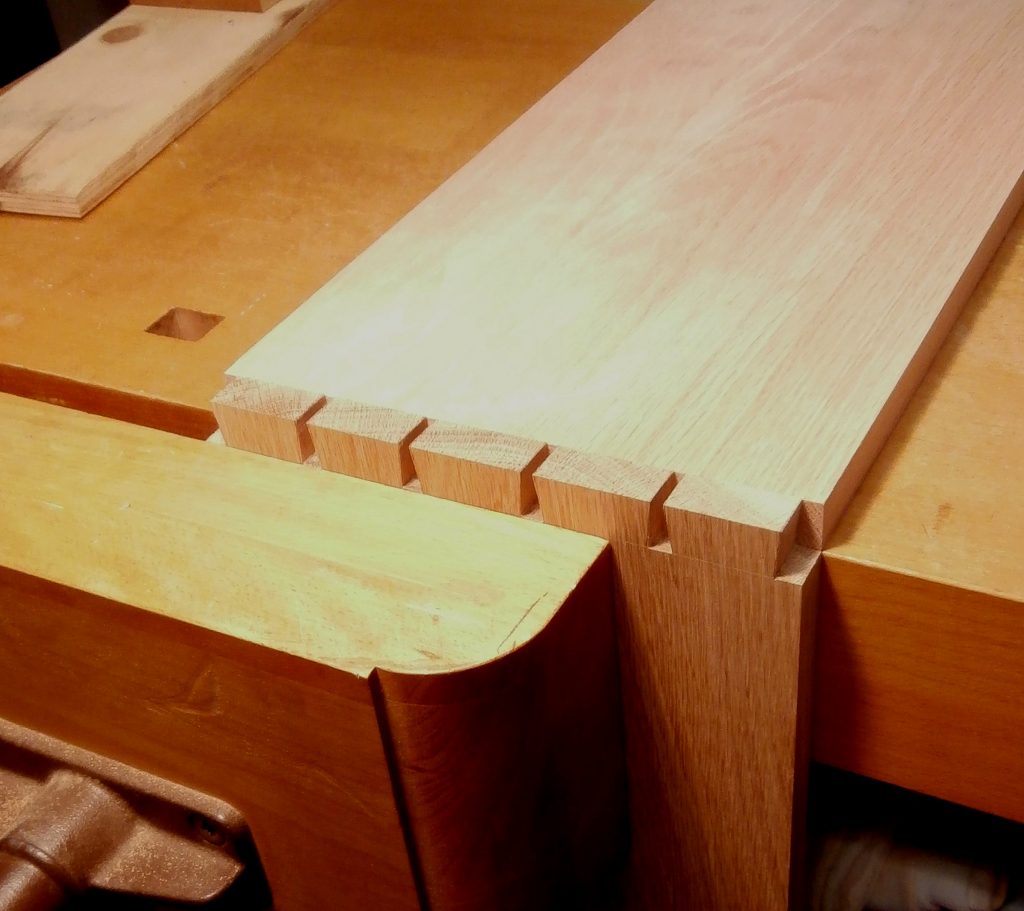
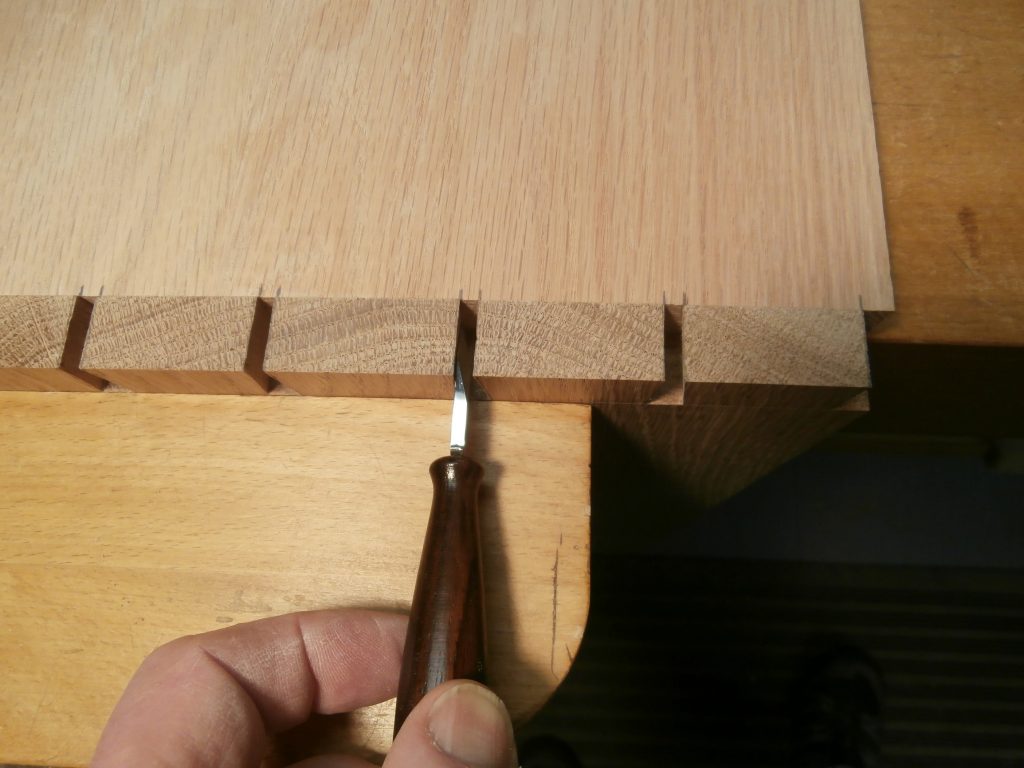
Next, I fully outline the pins with a pencil to guide my cuts. This is slow work but yields good results.

Since I planned to have a recessed back panel for the wall cabinet, after cutting the tails and pins for all four of the case frame pieces, I took this opportunity to cut the stopped rabbets around the back edges of the case pieces as well. See Below.

The six drawers, with American elm sides and Black cherry drawer fronts, have through dovetails on the back corners and “half-blind” dovetails on the front corners. “Half-blind” means that the tails do not go all the way through the adjoining boards so that they do not show on the face. My technique for the half-blind dovetails was basically the same as that for through dovetails. See below.

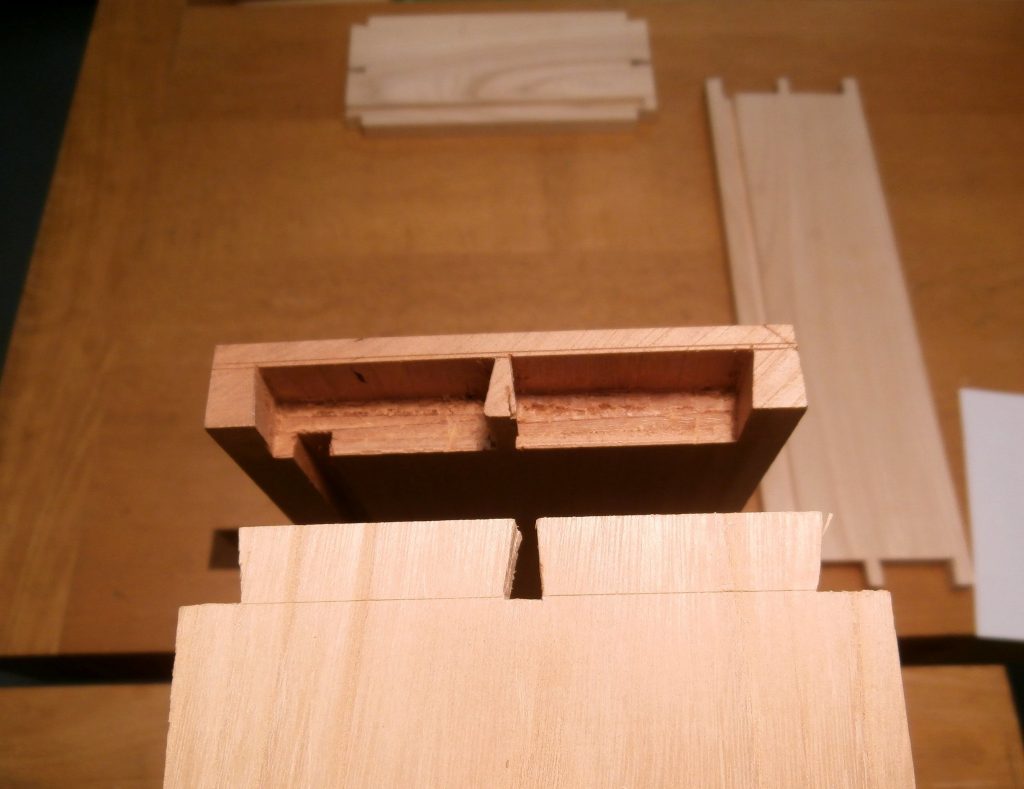
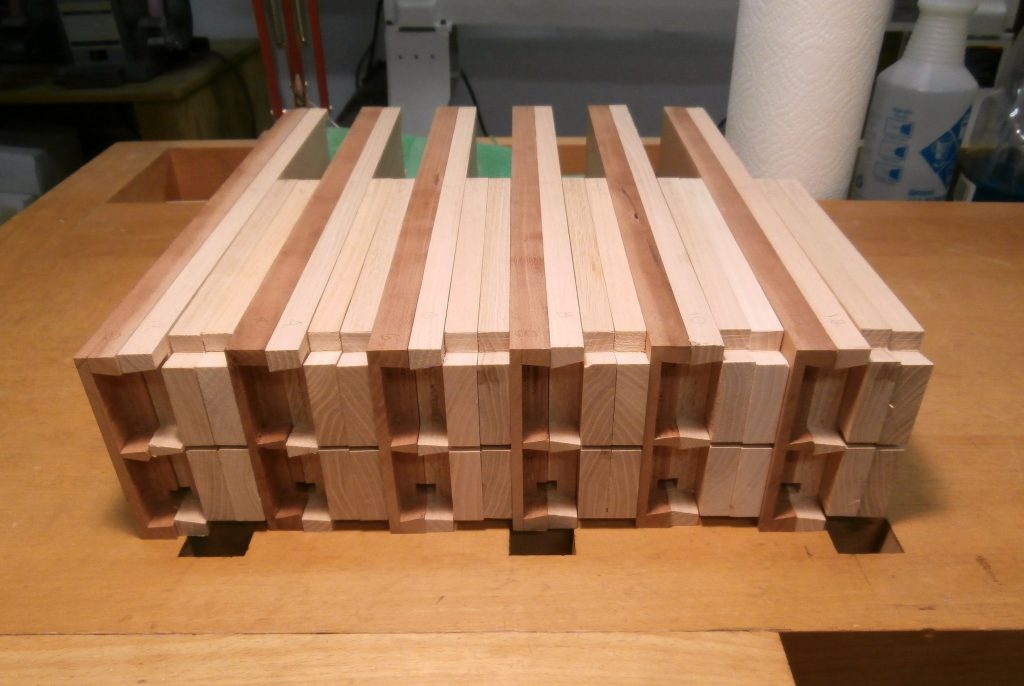

After cutting the 3/16″ oak plywood for the drawer bottoms, I cut and shaped a piece of Sugar maple with the table saw and a router to be cut into individual lengths for drawer pulls. Then I cut stopped dadoes on the outside faces of the drawer sides before final assembly, and made and attached matching wood drawer guides on the inside faces of the case pieces .
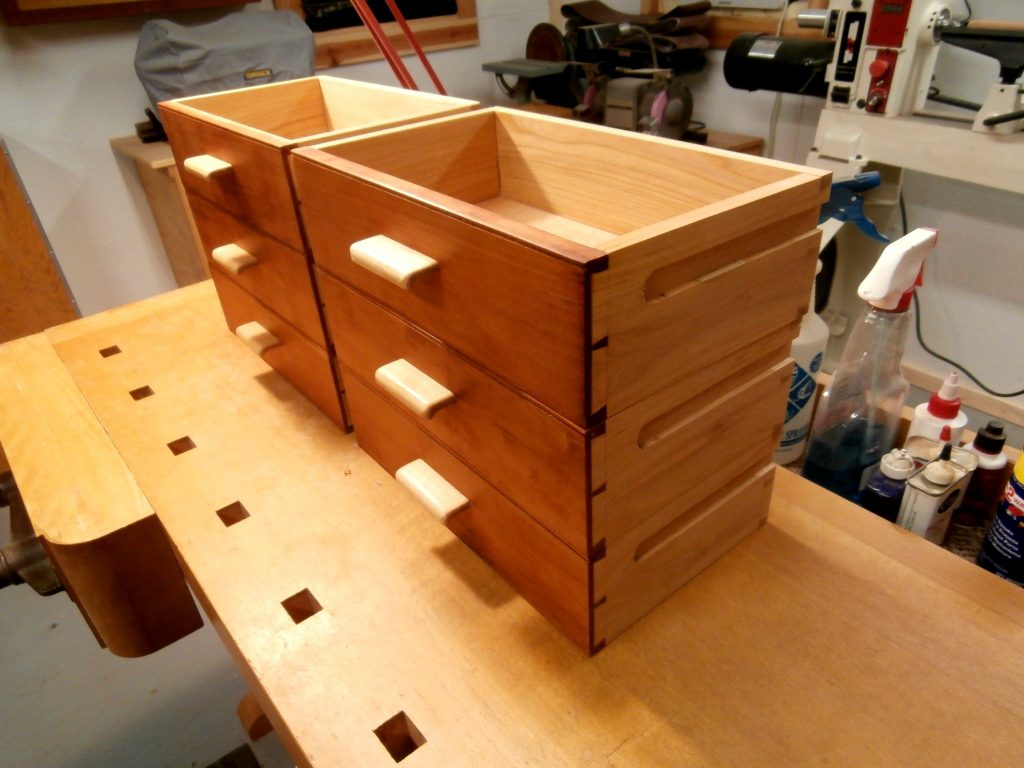
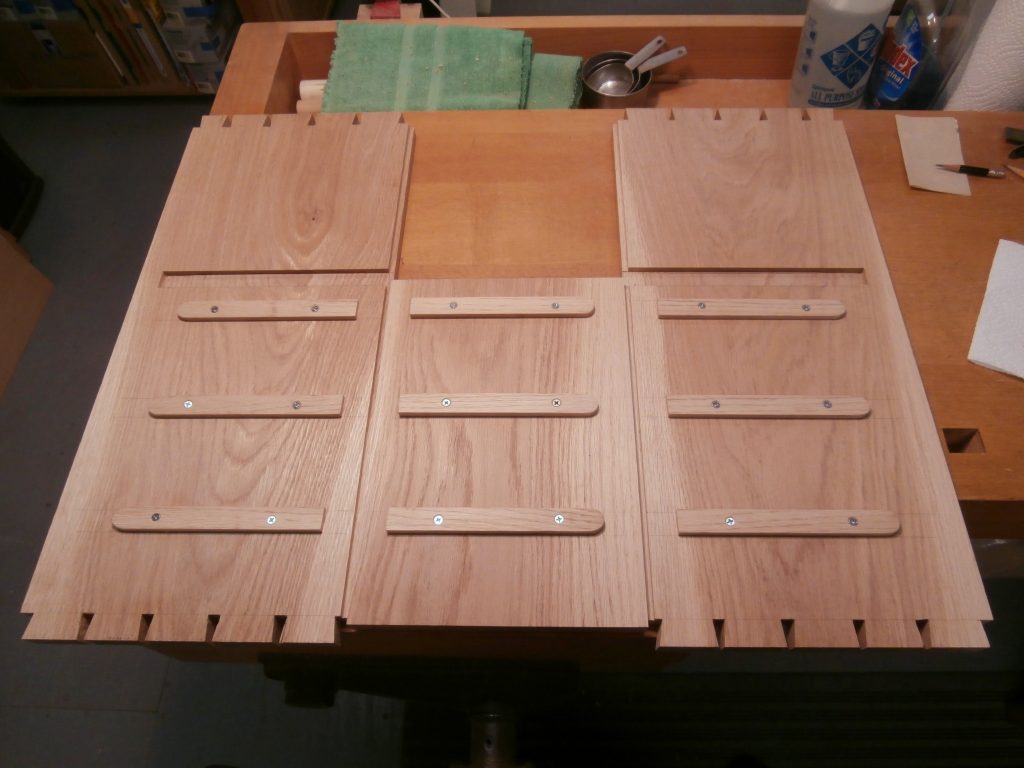
What remained was assembly and finishing with clear/natural Watco Danish Oil.
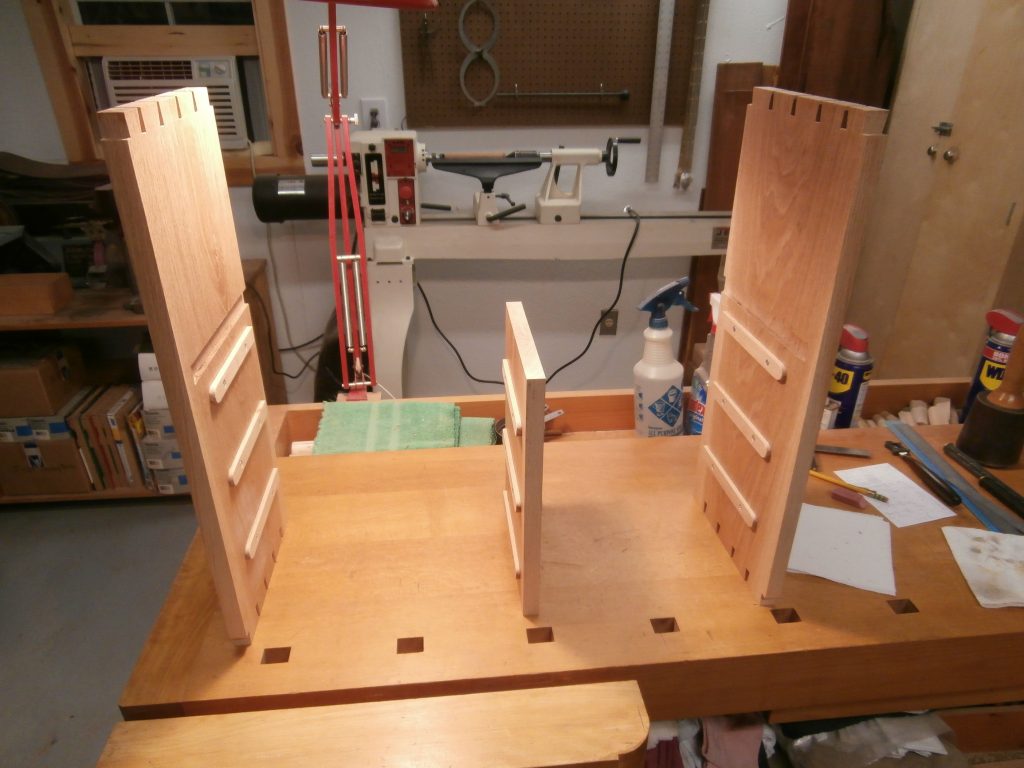

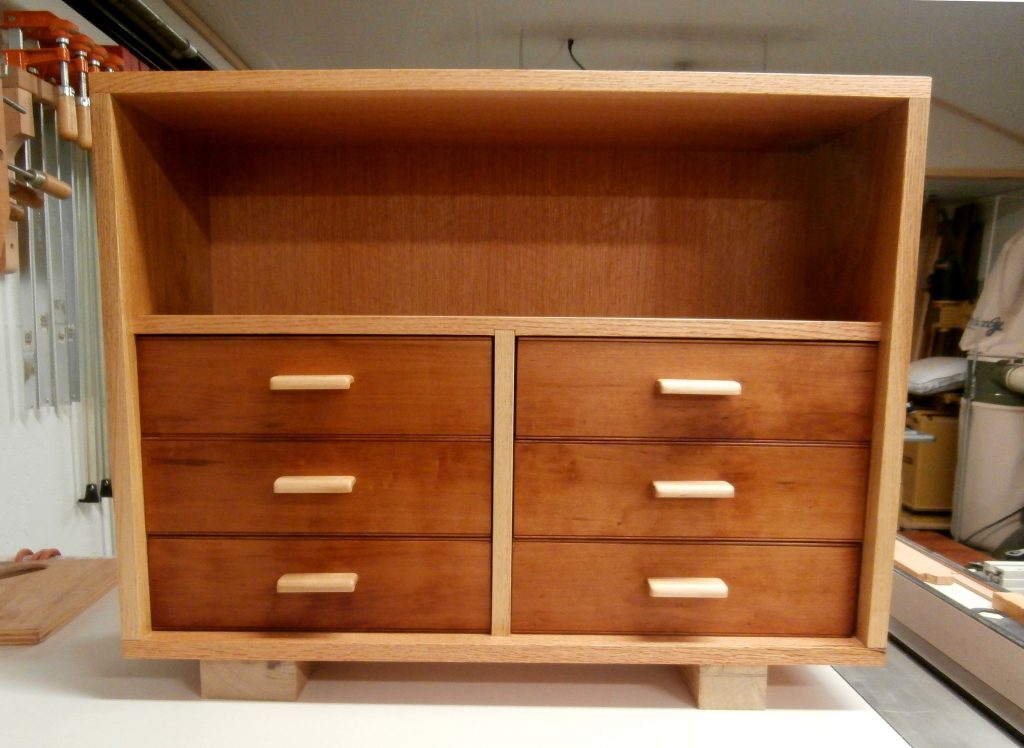
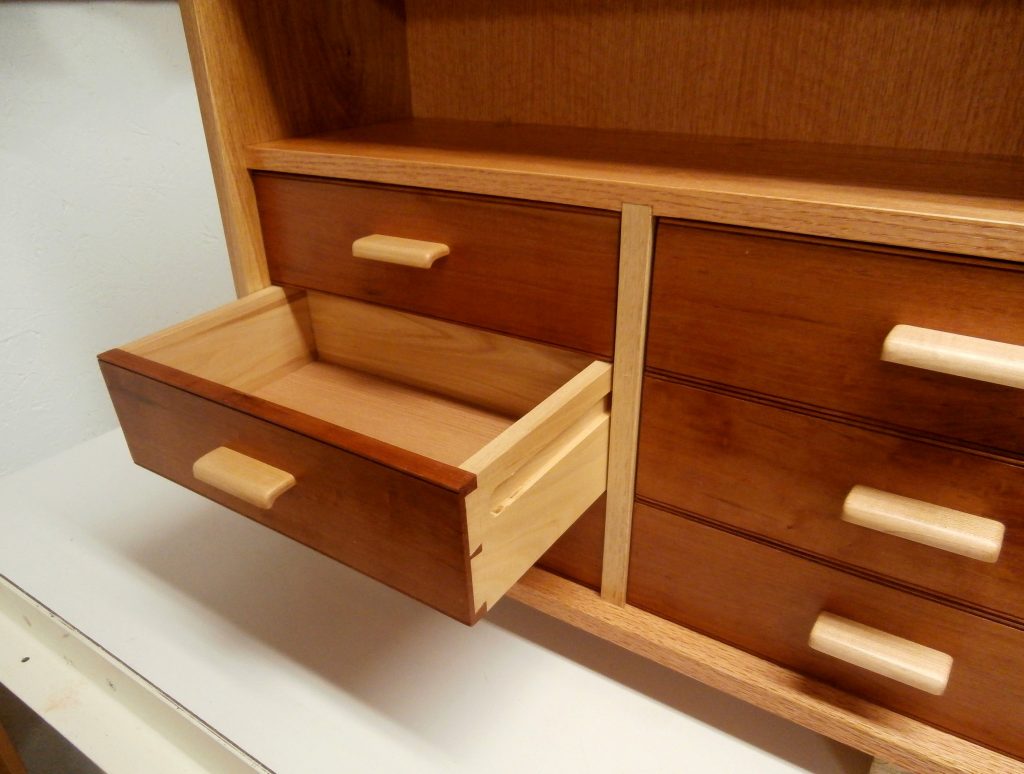
To hang the wall cabinet, I used a piece of oak with an angle cut mounted to the back of the case that mates with another oak piece, with the complimentary angle cut, that is mounted to the wall. In this way the cabinet can be hung and removed as needed.
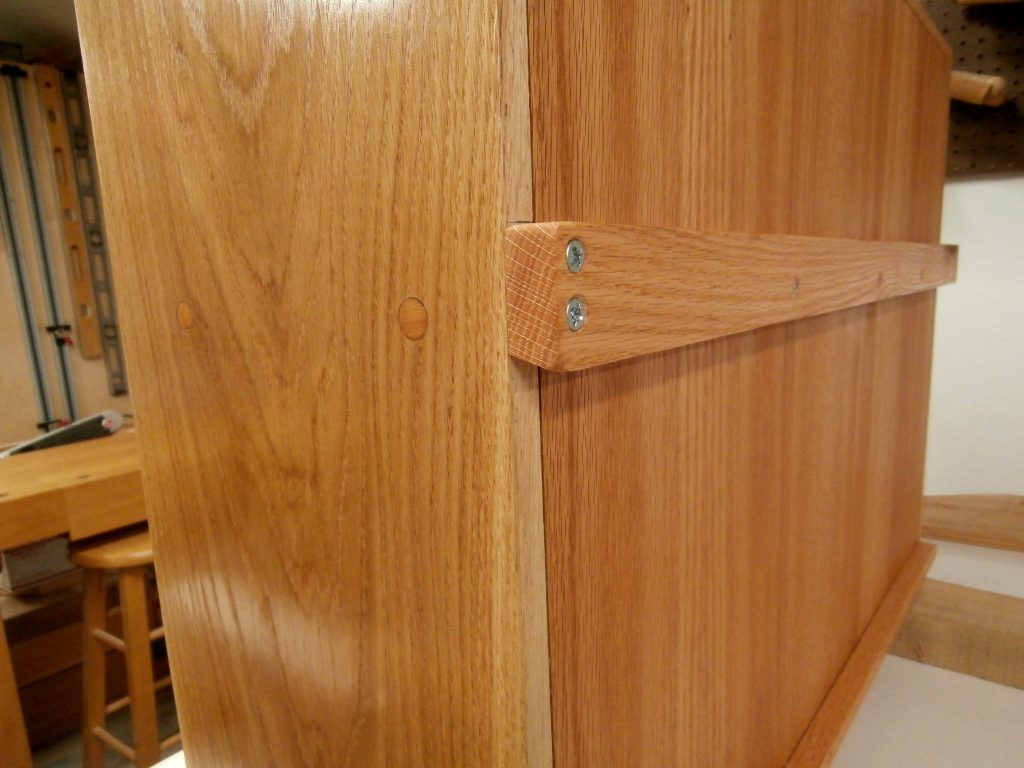
I designed my tall bookcase with a small footprint to hold a quantity of books without occupying a lot of floor space. The case is just under 83″ tall, but is only 31″ wide. No one wants a bookcase toppling over on them, so I designed the lower cabinet section and base to project forward, thereby bracing the upper portion. The sides of the case are primarily made from two full length, 14″ wide, clear, 1″ thick, red oak boards . . . too nice to be cut down. I started with a simple but scaled drawing to guide my work. I worked out the details and made separate drawings as I went along. [All photos ![]() Max Vollmer, Click on any photo to enlarge]
Max Vollmer, Click on any photo to enlarge]

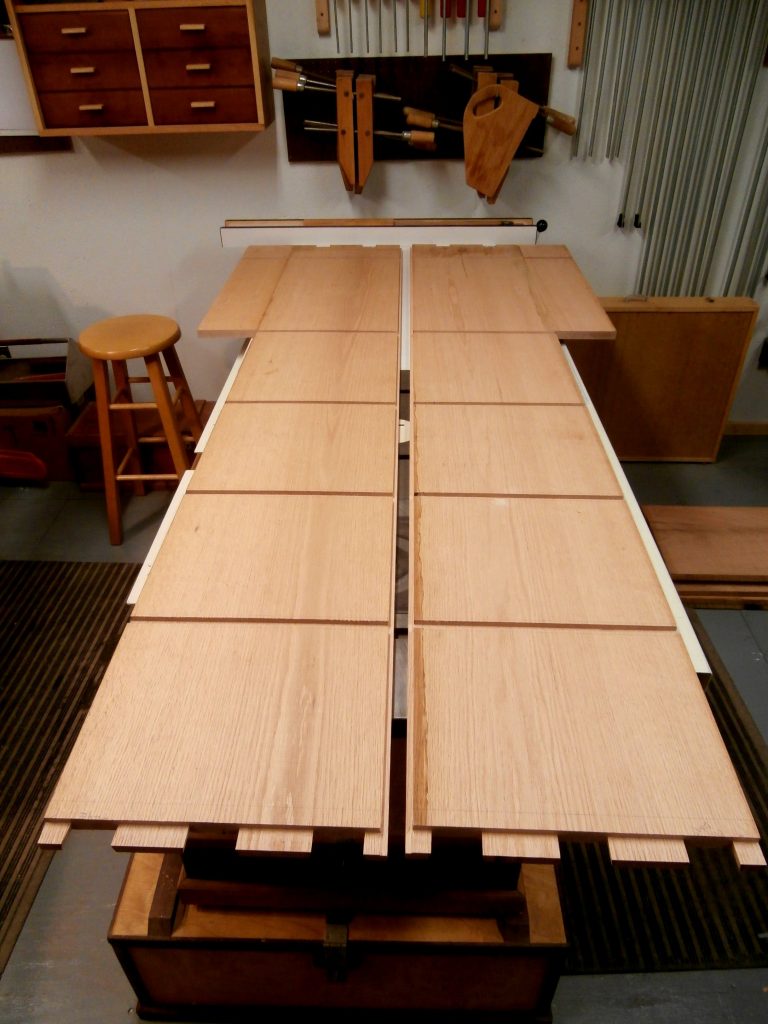
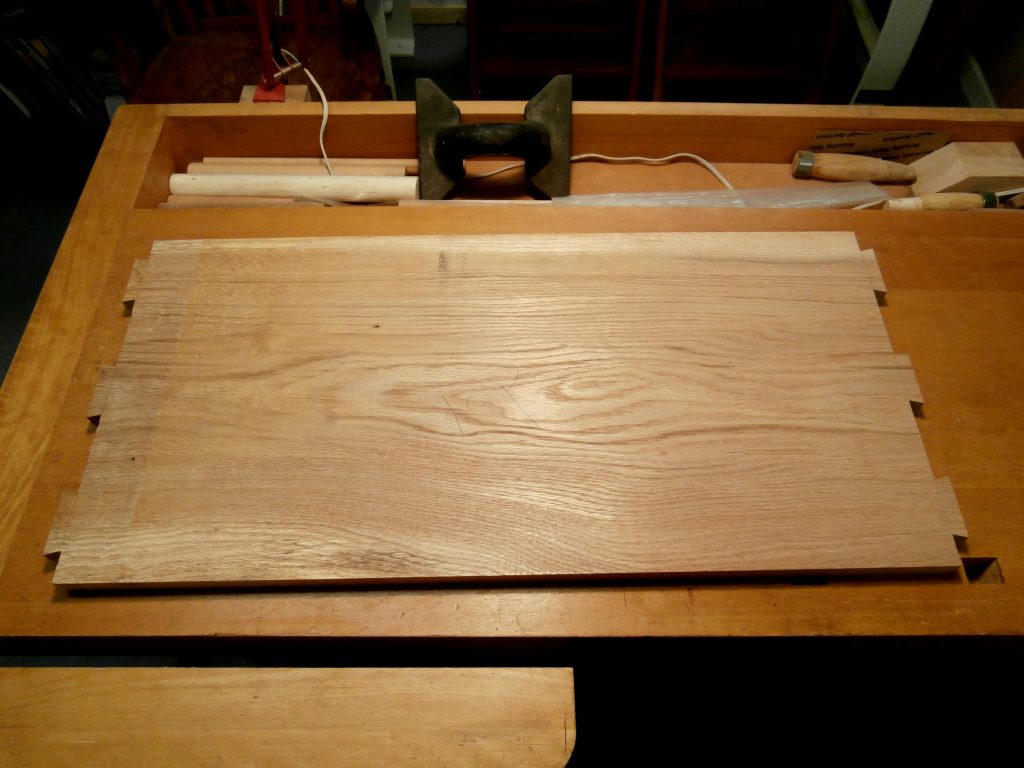
Having cut tongues on the individual 14″ wide, 1″ thick shelf boards, including the extra deep shelf that doubles as the top for the lower cabinet, so that they would slide into the dadoes on the sides, I was faced with the initial assembly of the long case. As you can see, I set the two sides on edge on two sawhorses, then affixed the solid top and two bottom cross pieces, using four very long pipe clamps to hold everything in place while the glue dried. [Aside: an option would have been to join the shelves to the case sides with sliding dovetails, but I don’t have a shaper or router table so I opted for saving time.]
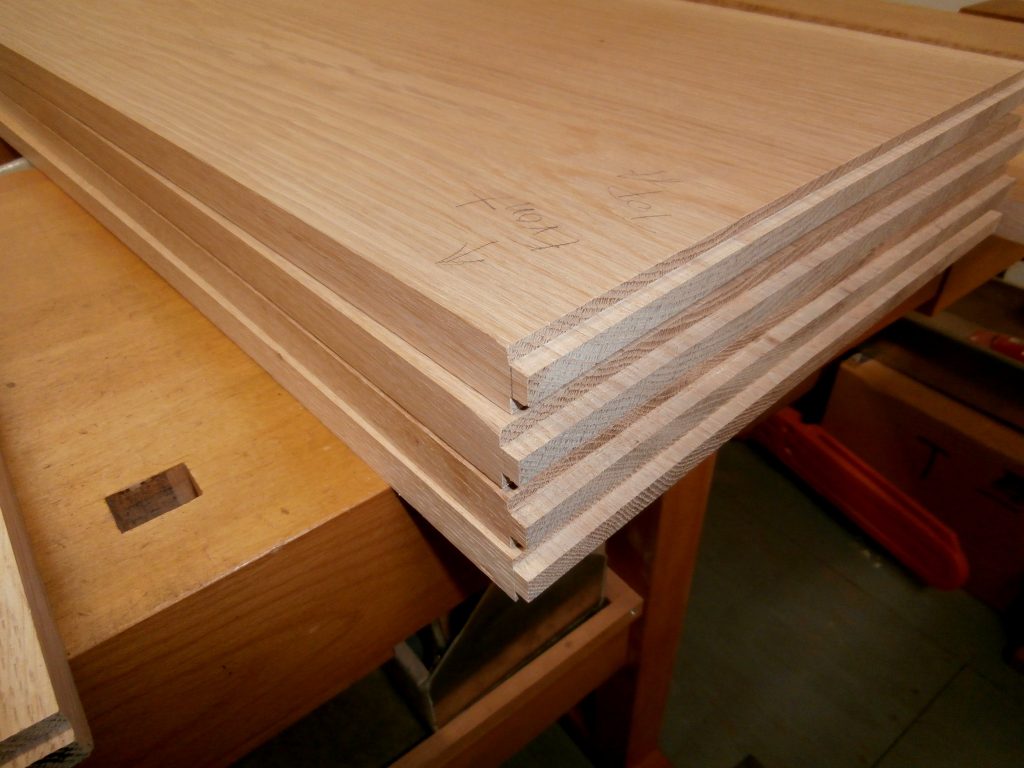
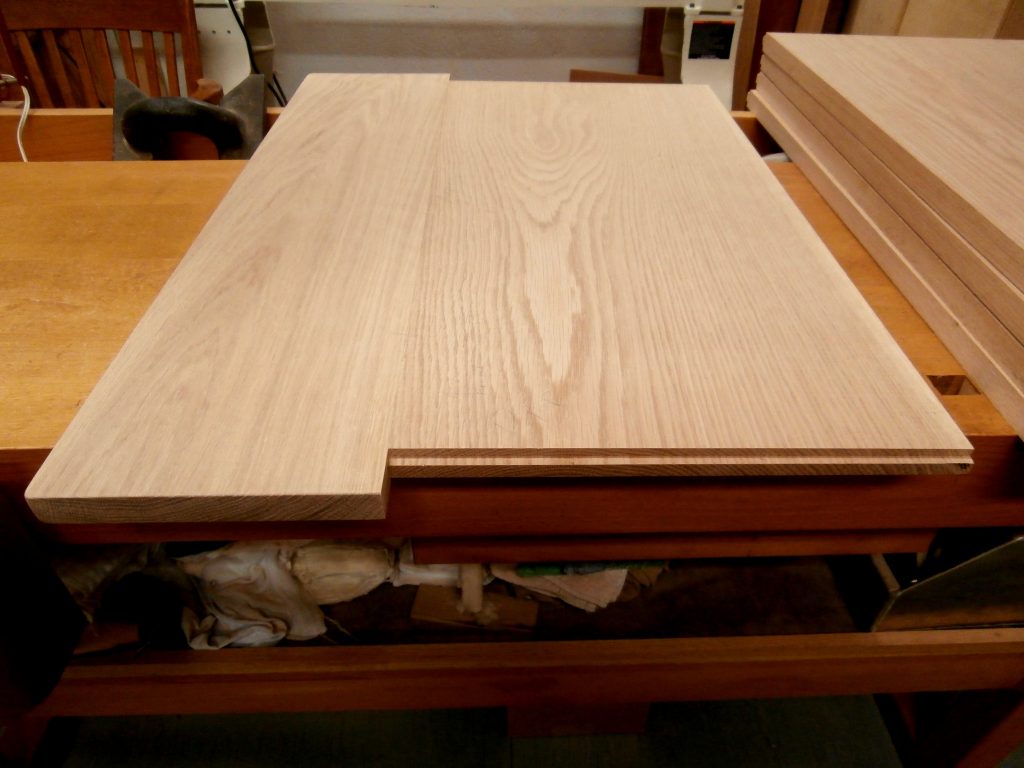
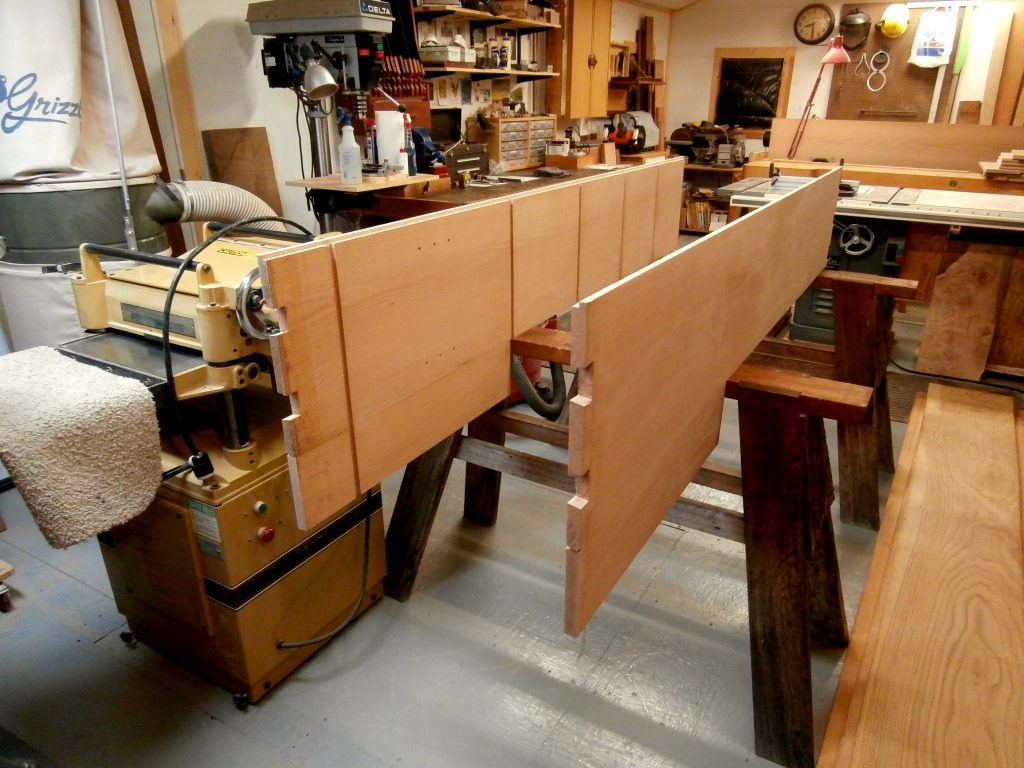
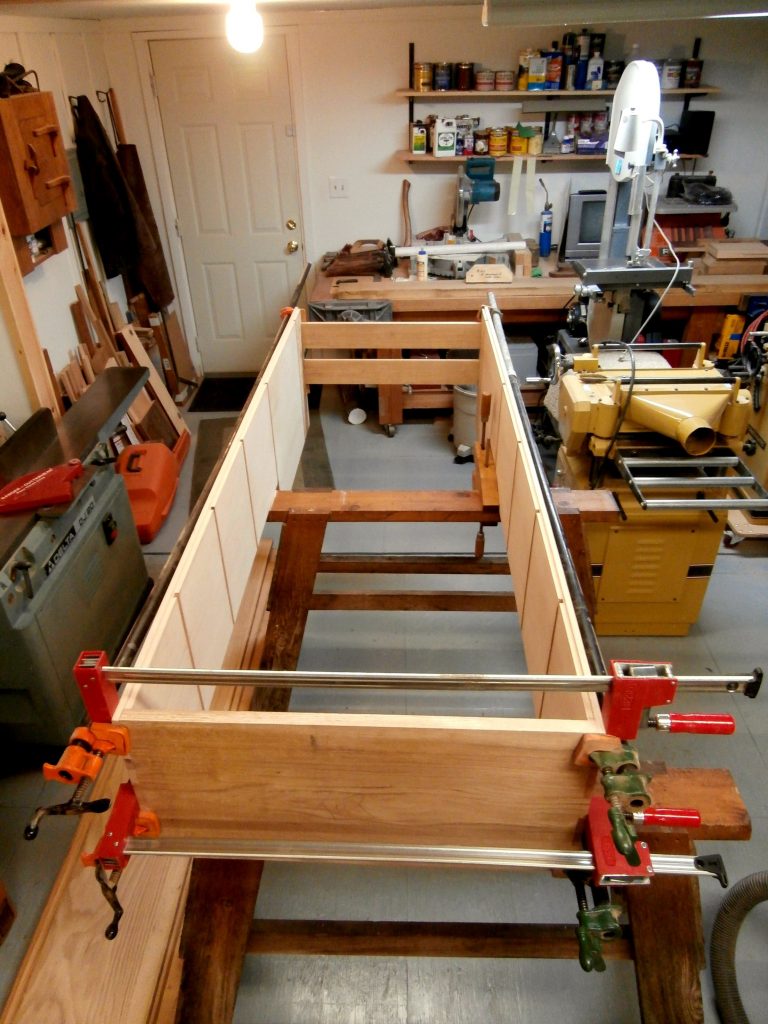
With the shelves glued in place, the basic case took shape. The shelf spacing is graduated from bottom to top: approx. 13, 12, 11, and 10 inches respectively. The dovetails joining the solid top to the sides can be seen in the photo below.
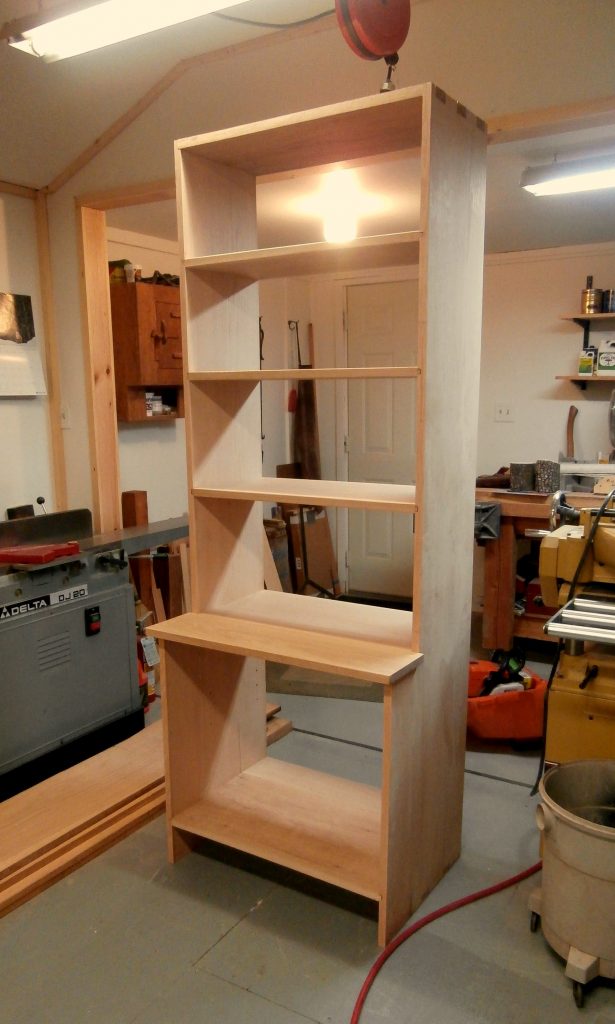
I made and attached the trim pieces at the top of the case and installed the oak plywood back. The back provides rigidity (i.e. 90 degree corners) for the whole case. I also applied trim pieces to both front edges of the upper case to hide the shelf dadoes and to generally improve the overall appearance.
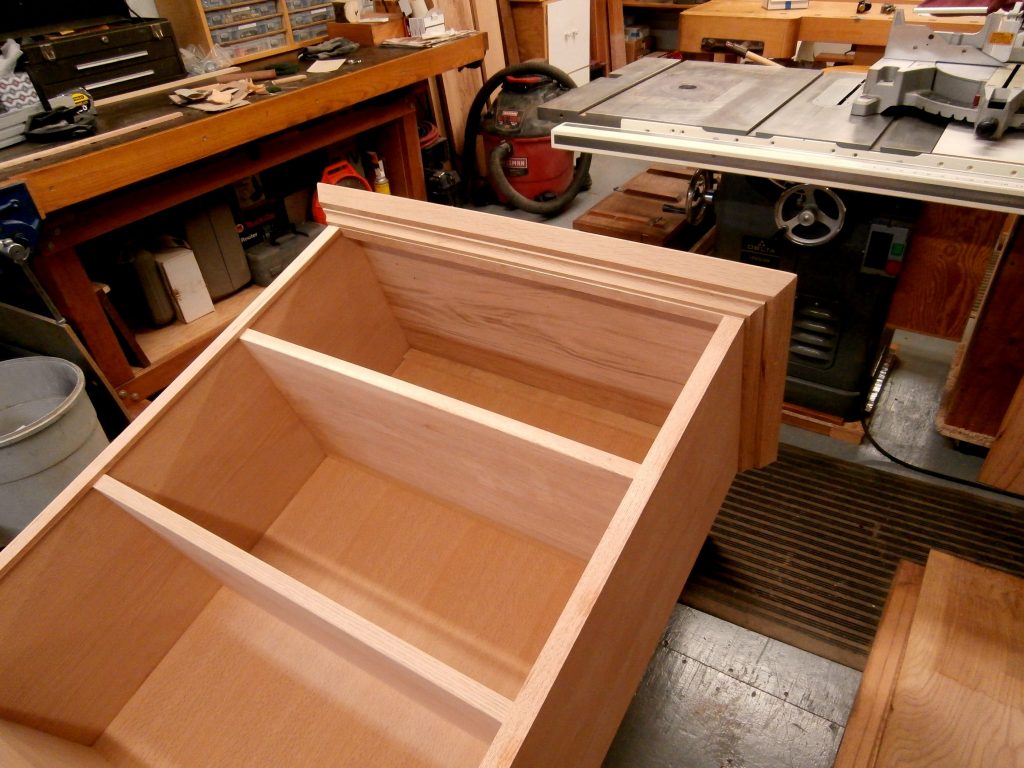
To finish off the raw bottom edges of the sides and to provide some of the stability envisioned in the original design, I cut long grooves, technically “stopped dadoes,” into two pieces of 2″ thick oak to make what look like “shoes” to cover the “feet” of the cabinet. I then applied a face frame for the lower cabinet section.
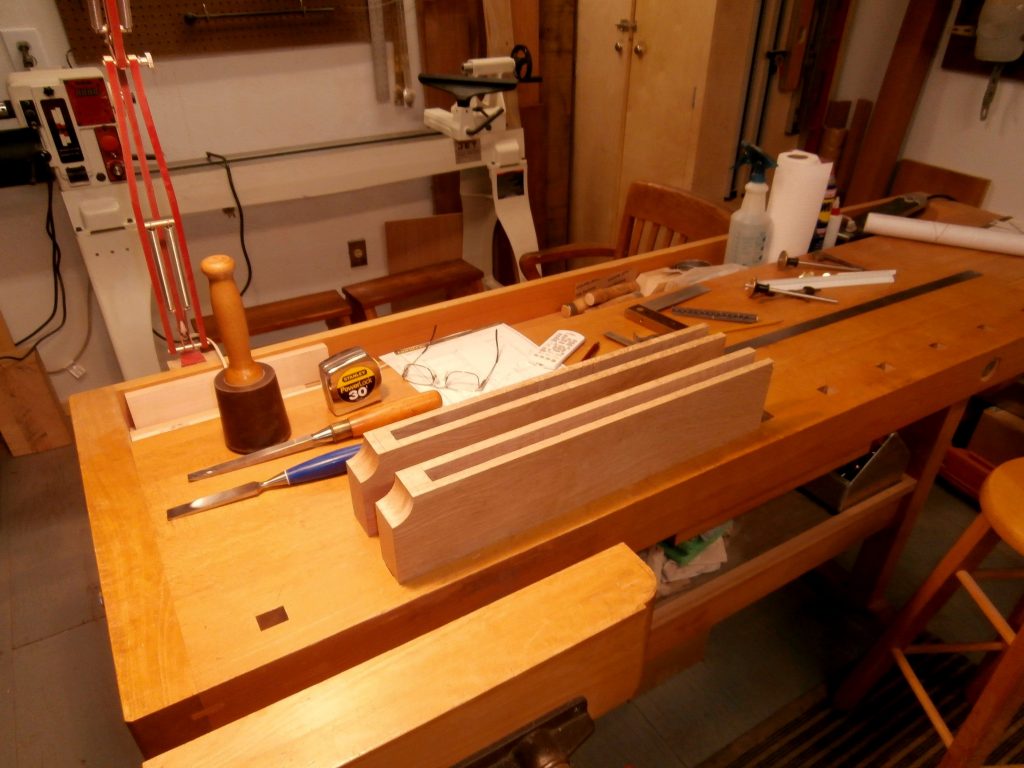
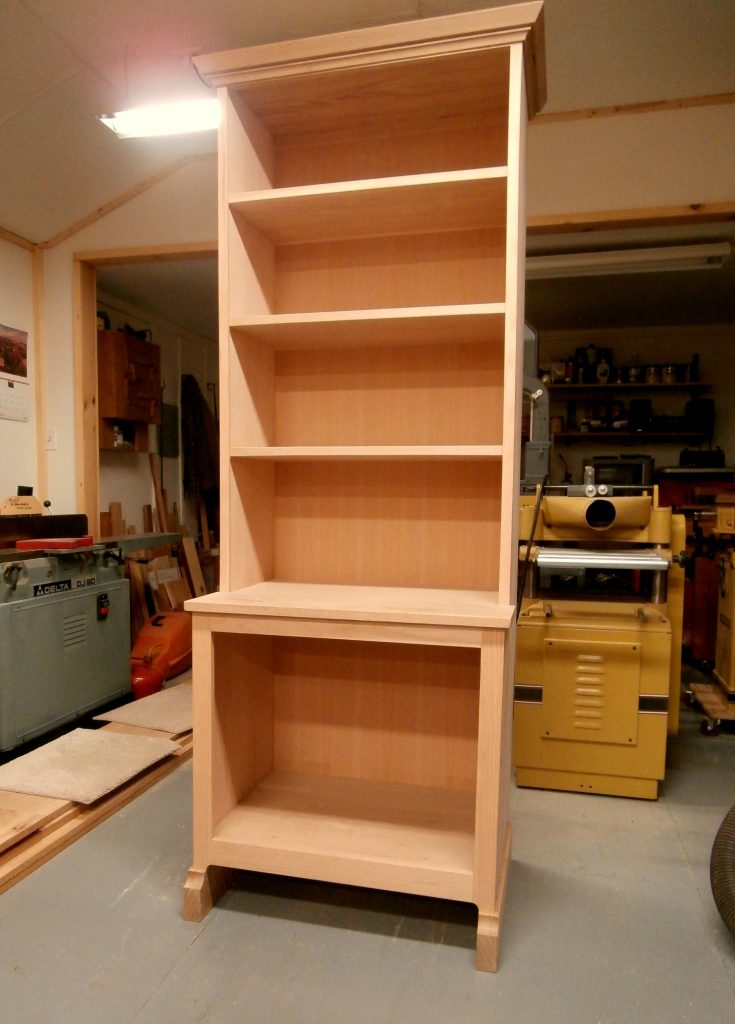
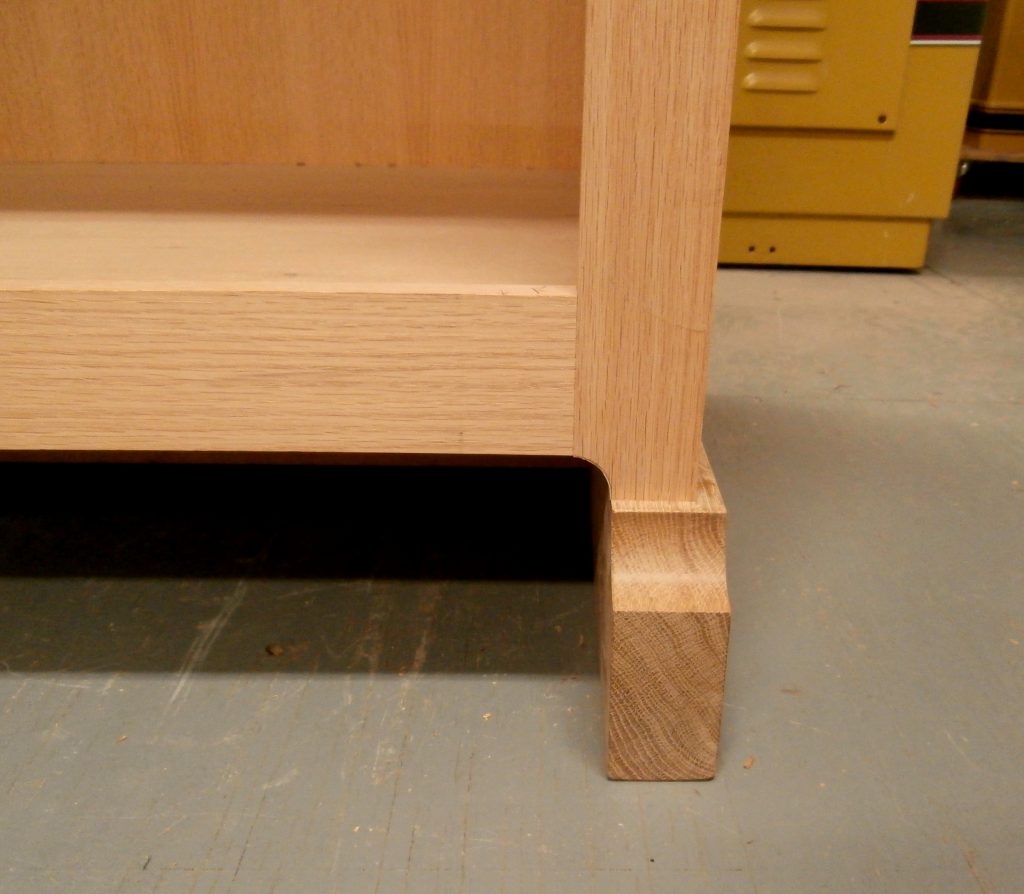
For the cabinet doors on the lower section, I made panels out of a streaked and water stained piece of red or black oak that I rescued 40 years ago from the mud of John Root’s sawmill yard in Fishersville, VA, where it had been driven over multiple times by a forklift. It had “character” and had been hanging out in my wood stash all these years just waiting for the right application.
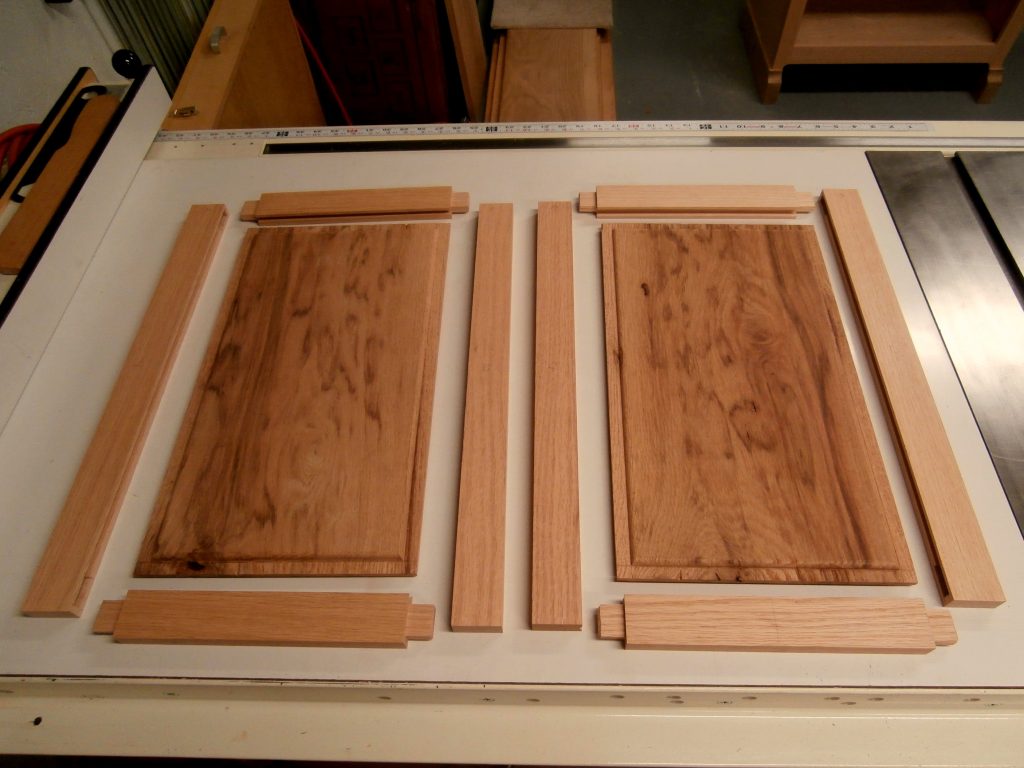
The doors, with brass pulls, were installed with brass leaf hinges. An adjustable shelf was added in the lower cabinet section. All that remained then was to finish the bookcase with one coat of Minwax (natural) for a sealer and two coats of Watco Danish Oil (clear).
Hélène Grimaud brings great skill, passion, and sensitivity to this piece written by J. S. Bach for violin and transcribed by Feruccio Busoni for piano.
I made this traditional West Greenland paddle for my son, a sea kayaker extraordinaire, out of a rough sawn sassafras 2″ x 4″. This one is actually called a “storm” paddle because, at roughly 70″ (178 cm) long, it is shorter overall and has a shorter “loom” (the hand grip) than is true for a full size West Greenland paddle at approx. 8′ (244 cm). While the Inuit made their paddles out of whatever wood drifted onshore, I chose sassafras, a minor North American hardwood, because it is relatively strong, light, and holds up well in fresh and salt water. [All photos ![]() Max Vollmer, Click on any photo to enlarge]
Max Vollmer, Click on any photo to enlarge]

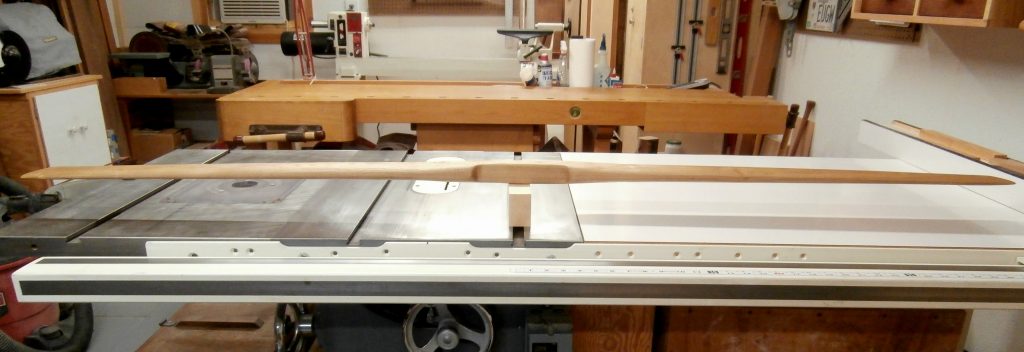
The simple appearance of the paddle belies the challenge involved in making one. My first steps were to mark out centerlines on both the thick and thin dimensions of the 2″ x 4″, as well as the location and shape of the loom. These lines guided me in creating the tapers in both width and thickness of the paddle blades.
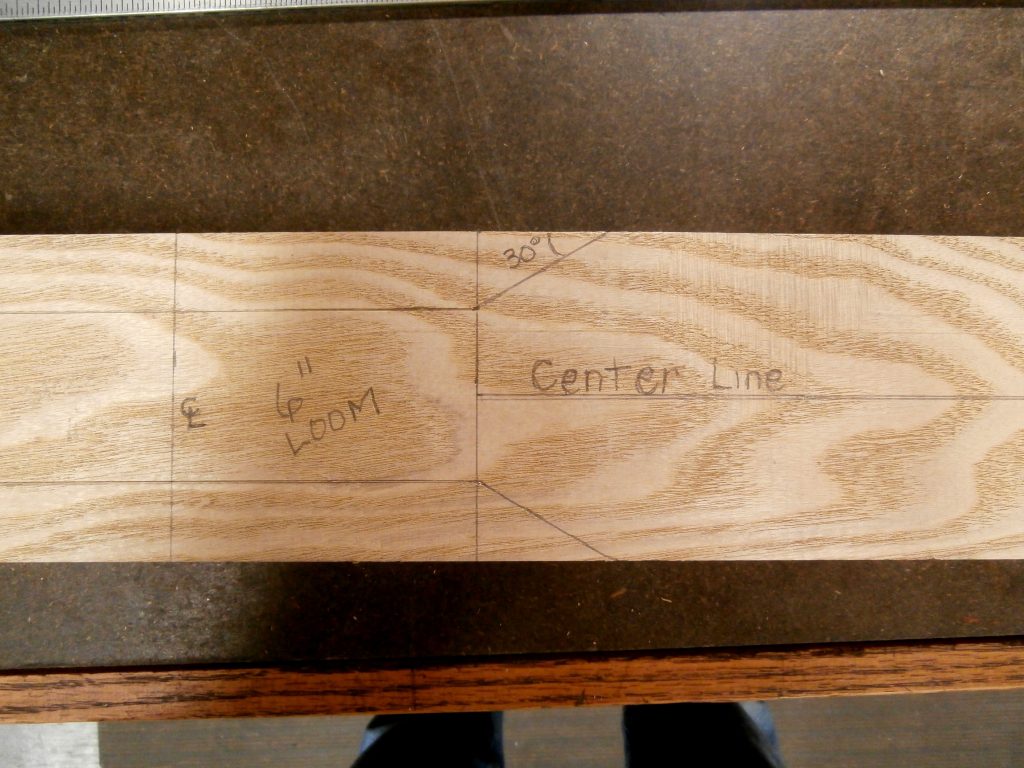
Next, I used my bandsaw to rough out the loom and then shaped the blades with a drawknife and spokeshave, finishing up with a belt sander.
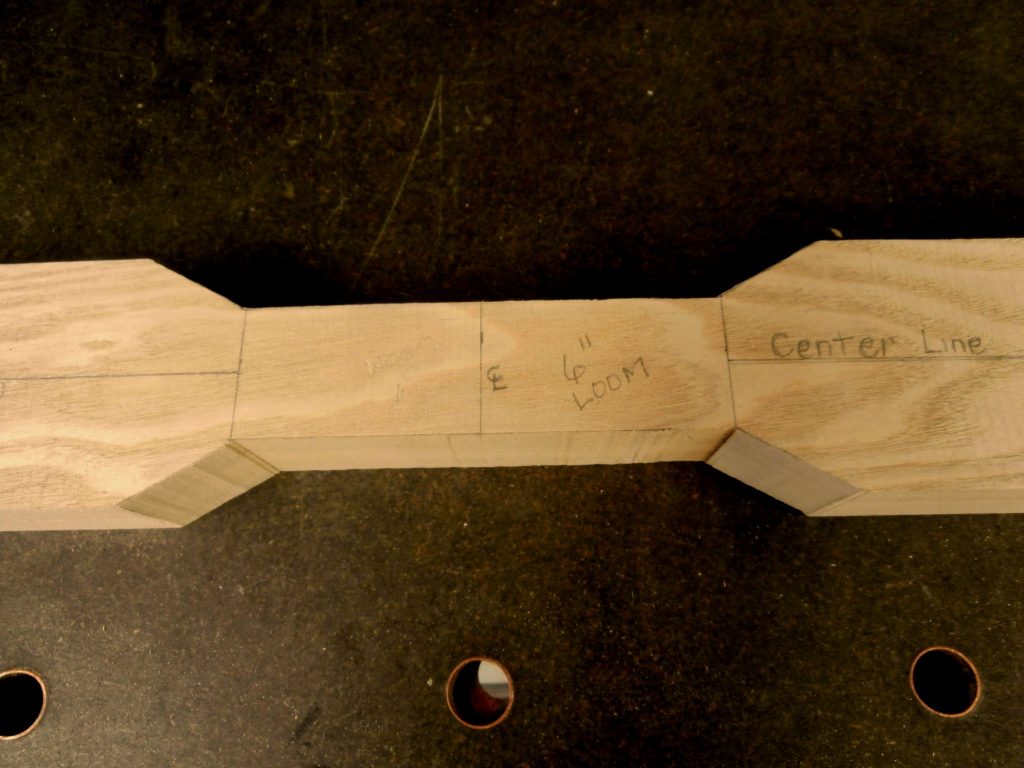
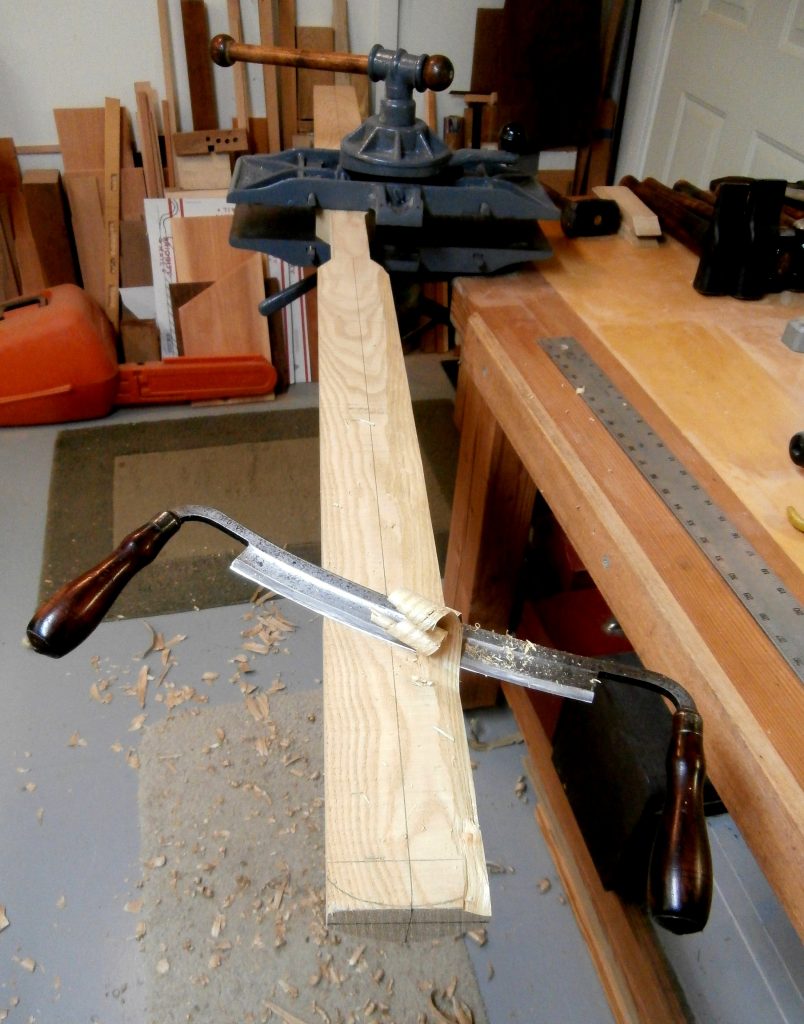
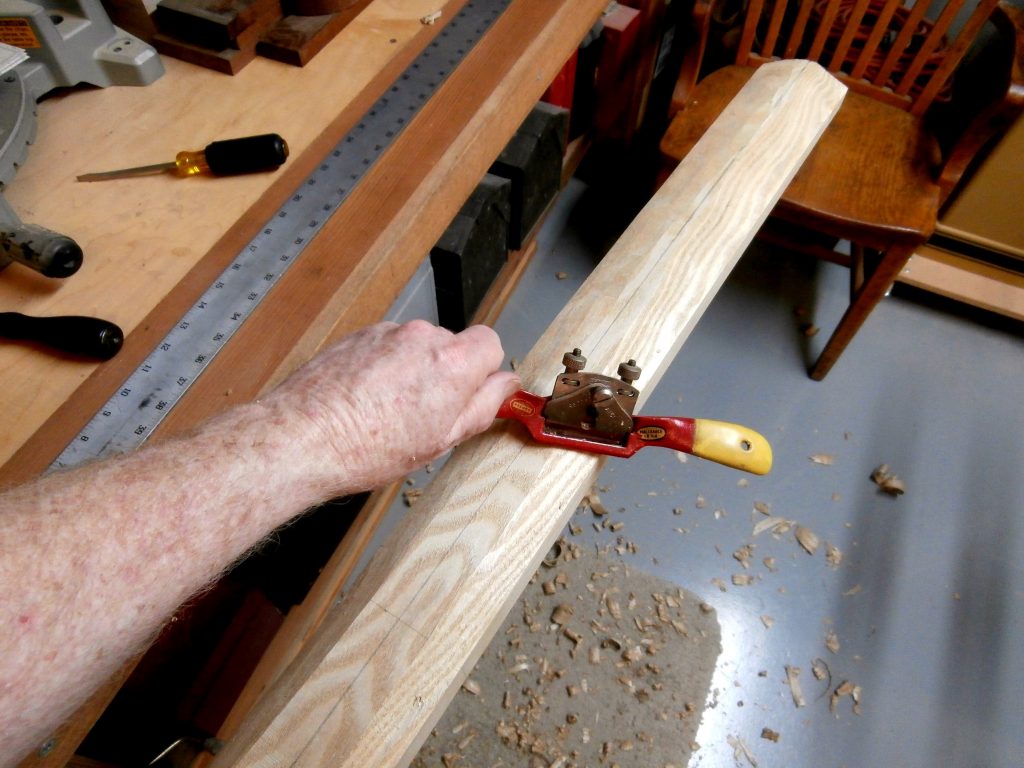
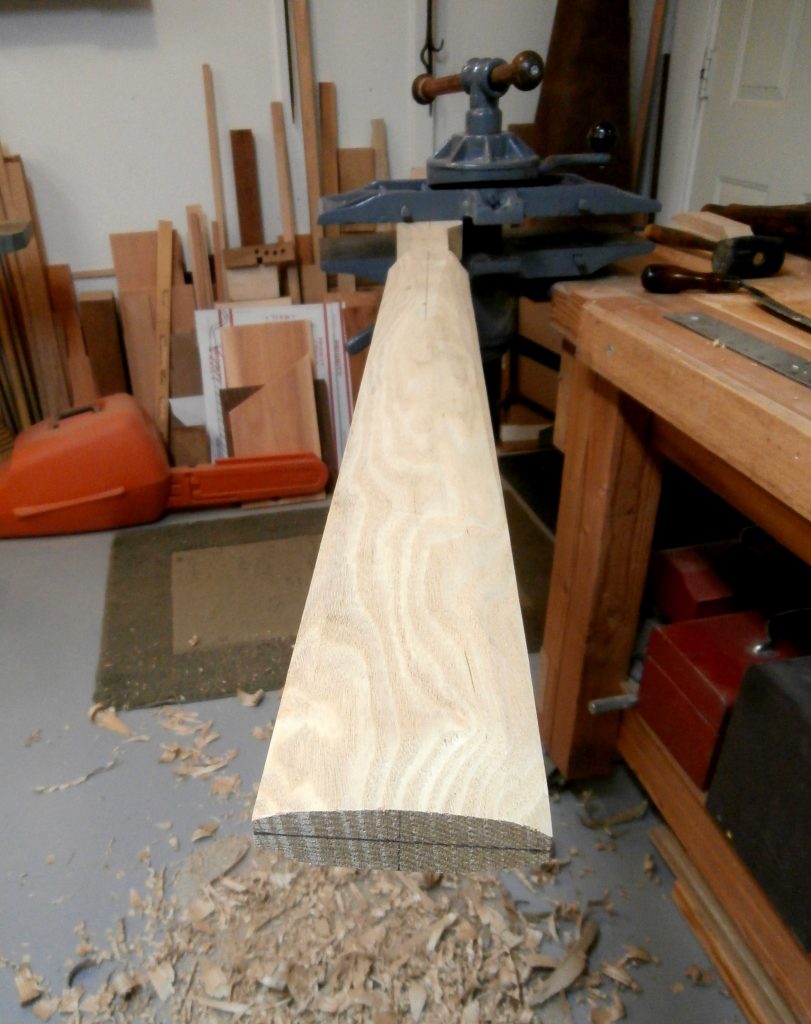
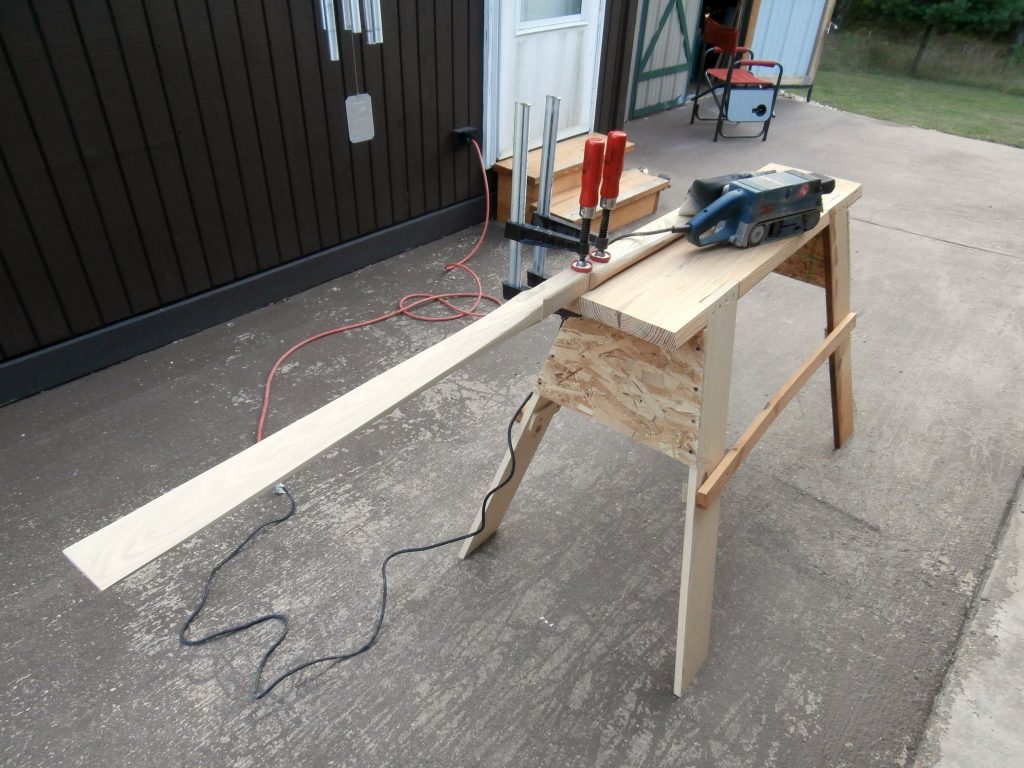
Holding the paddle “blank” in the grip of my 1930’s vintage Emmert patternmaker’s vise made this shaping possible. The Emmert has been known to generations of patternmakers as “The Iron Hand” for its ability to twist, rotate and lock its jaws in an infinite number of positions.
The loom is shaped so that the paddler’s thumbs can grip against “shoulders” cut at an approximate 45 degree angle on one side, while the fingers wrap around a splayed grip on the other side. The cross sectional dimension of the loom is sized to the individual kayaker’s hands, in this case to Karl’s hands. See the photo below.

I finished the paddle with two coats of 100% Tung oil. Tung oil has no VOC (volatile organic compounds), is slow drying between coats, but offers good protection for the wood in water and can be renewed as needed.
In 2006, I built a carved, aromatic cedar lined chest in Joseph, OR, that was inspired by an original “harinero” (flour storage chest) from northern New Mexico dating from the late 17th – early 18th century. My chest, like the original, is constructed with Ponderosa pine and is scaled and proportioned using the historic Spanish “vara” system of measurement (one vara = 33 1/3 inches). At the time I did not have my blacksmithing equipment set up so the chest went without hardware until 2018. Here’s a photo of the chest without hinges and a hasp. (All photos ![]() Max Vollmer, Click on any Photo to Enlarge it.)
Max Vollmer, Click on any Photo to Enlarge it.)
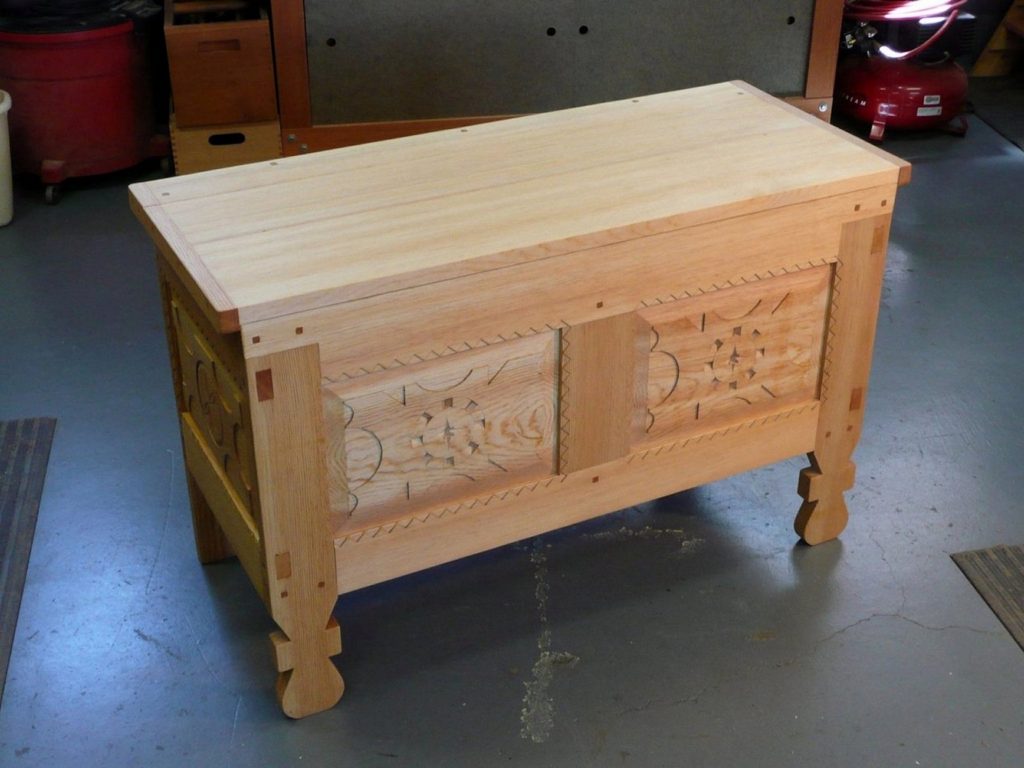
I made scale drawings of the strap hinges and hasp I wanted for the chest in the style of 17th~18th century, northern New Mexico. I used mild steel to forge the parts and a hack saw to make cuts for the barrels/knuckles of the hinges. The next four photos show intermediate steps in the forging of the scrolls for the two-part hinges and hasp.
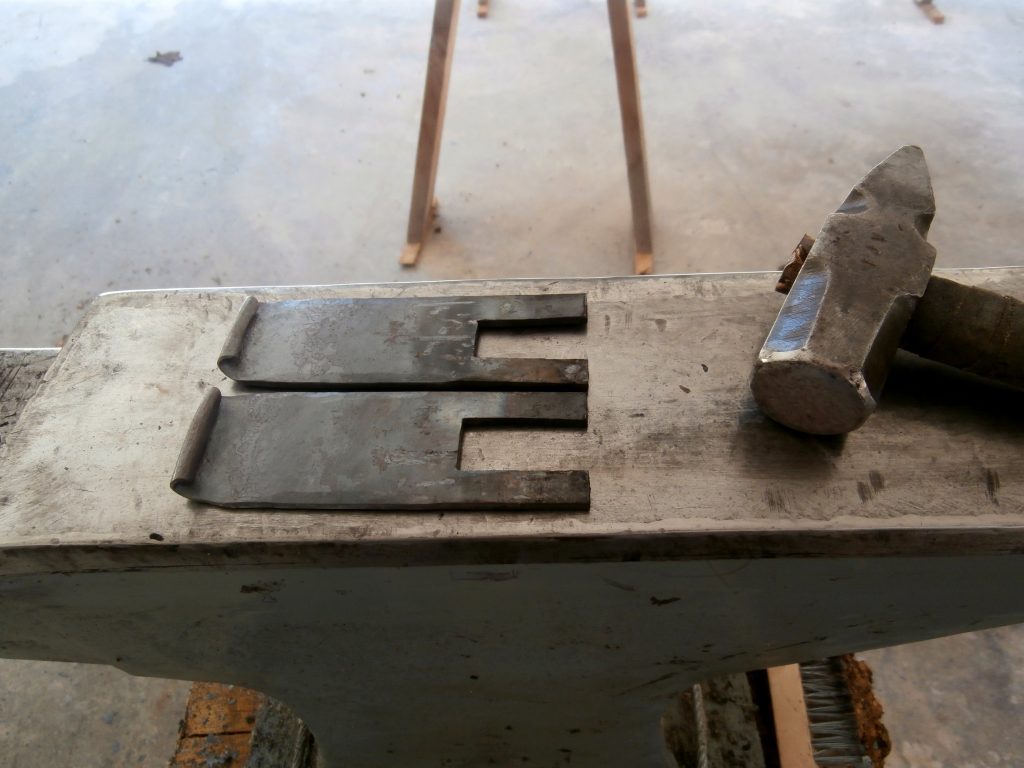

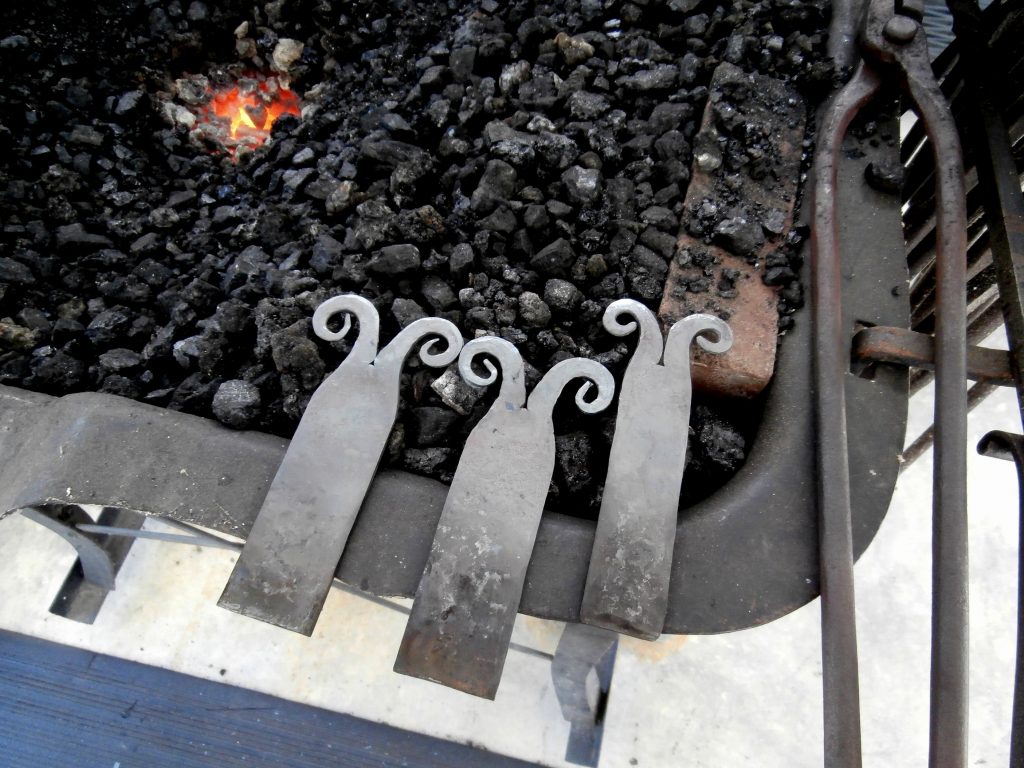
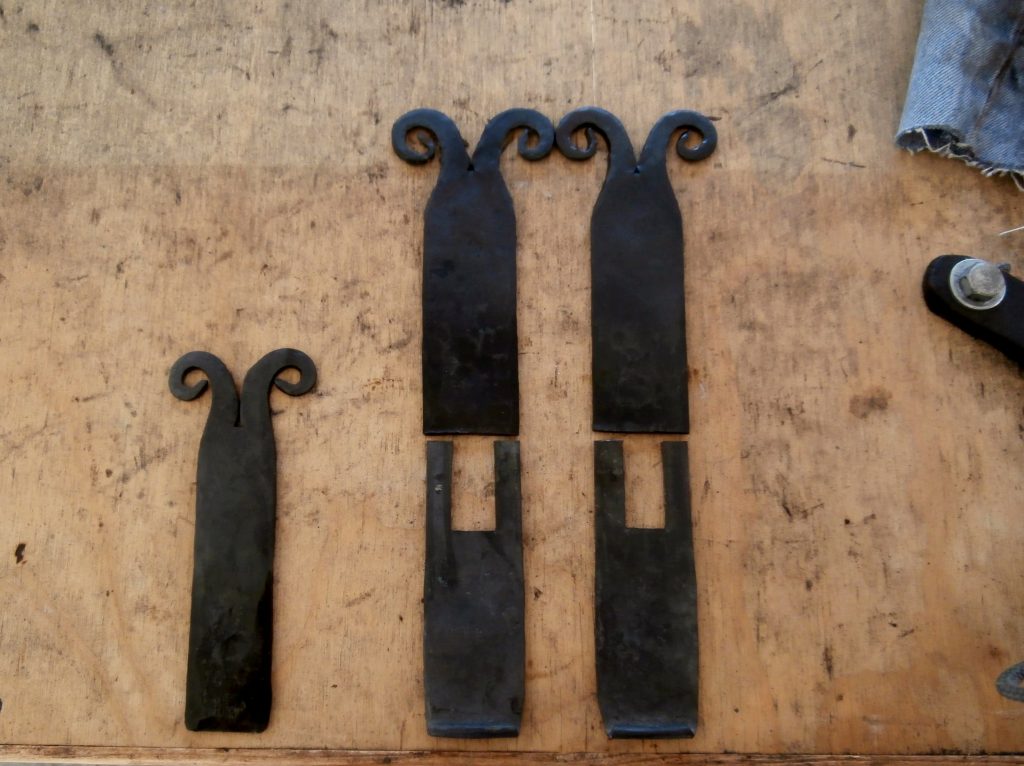
The next photo shows the design for the latch part of the hasp marked on the steel with magic marker so that I could rough cut and file that part before going to the forge to finish it.
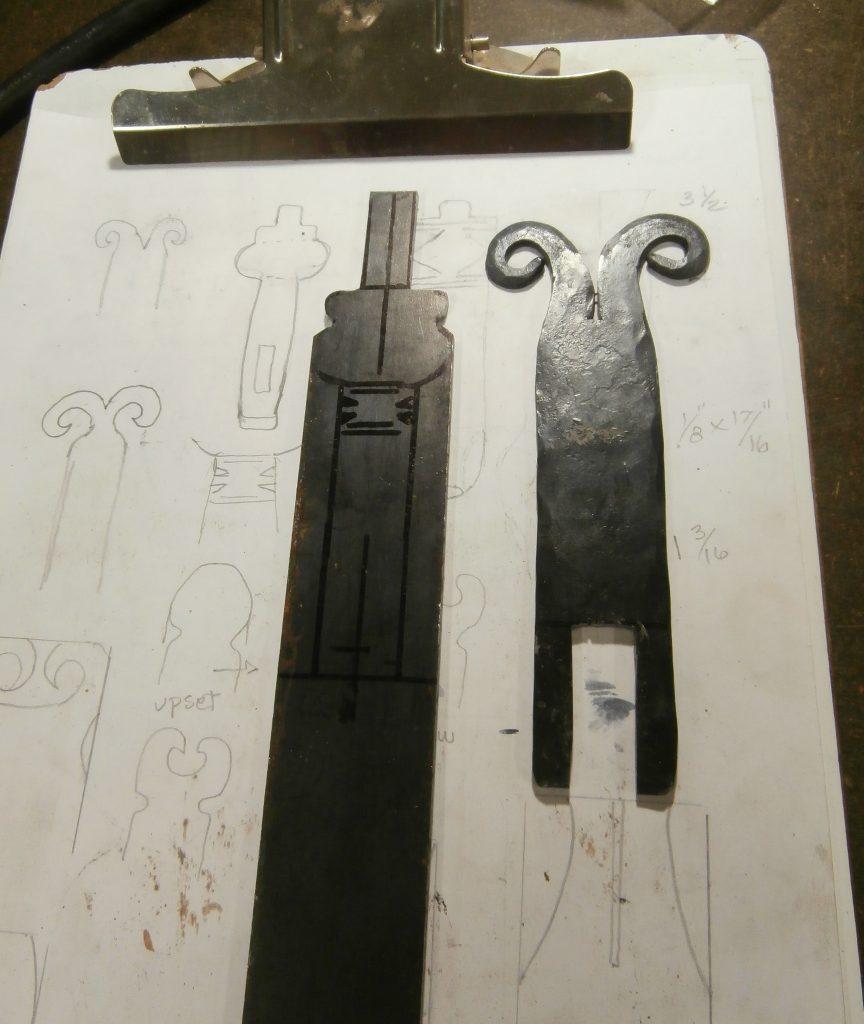
After shaping all the individual parts, I cut pieces of steel rod for the pintles (the pins) around which the the gudgeons (barrels or knuckles) of the hinge parts rotate. The pins were held in the jaws of the post vise so that the gudgeons (yellow-hot at 1800 degrees F) of the hinge, straight from the forge, could be hammered/forged around the pins. The next picture shows the hinge and hasp parts joined together, plus a 3″ square, hammer-textured plate and “staple” (U-shaped) to which the latch part of the hasp would attach.
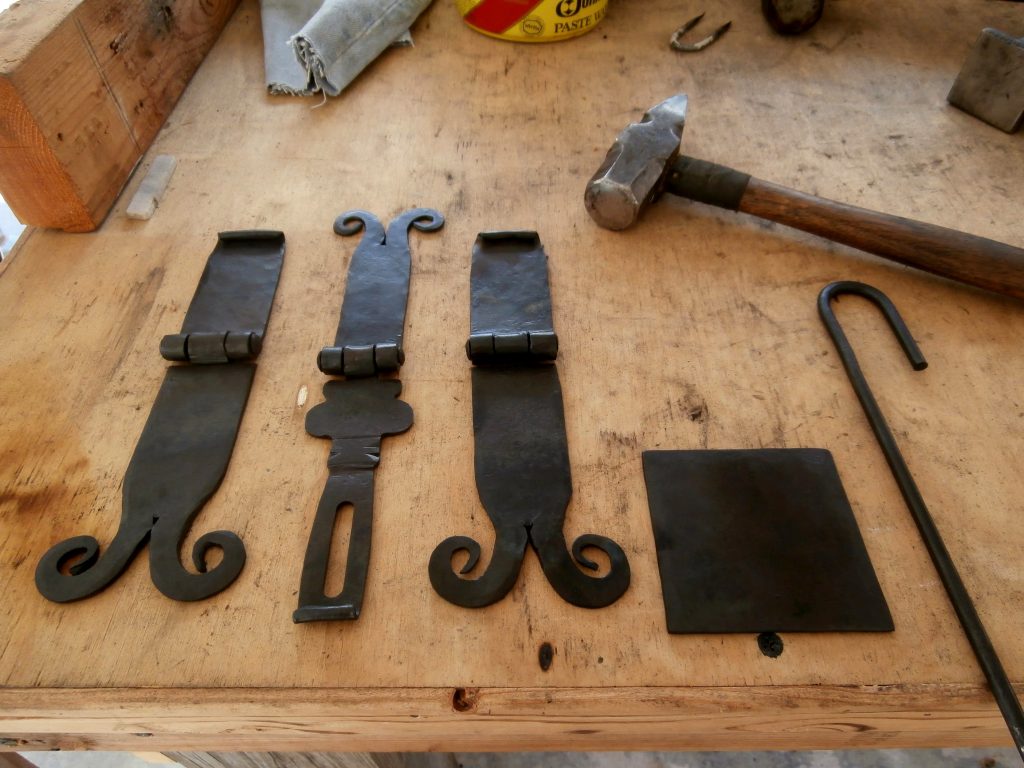
The next photo shows the assembly of the 3″ square plate and staple to complete the second part of the hasp. To do that, I drilled two holes in the 3″ square plate to match the U-shaped staple “legs” . . . then in very rapid succession I heated the staple legs to yellow-hot in the forge, and holding the staple with tongs I cooled all but the tips in the slack tub, quickly clamped the staple in the post vise with the hot tips pointed up, fit the plate (with drilled holes) over the staple tips, and upset (hammered) the tips so that they mushroomed down over the back of the plate into shallow recesses I had pre-drilled with an oversize drill bit.
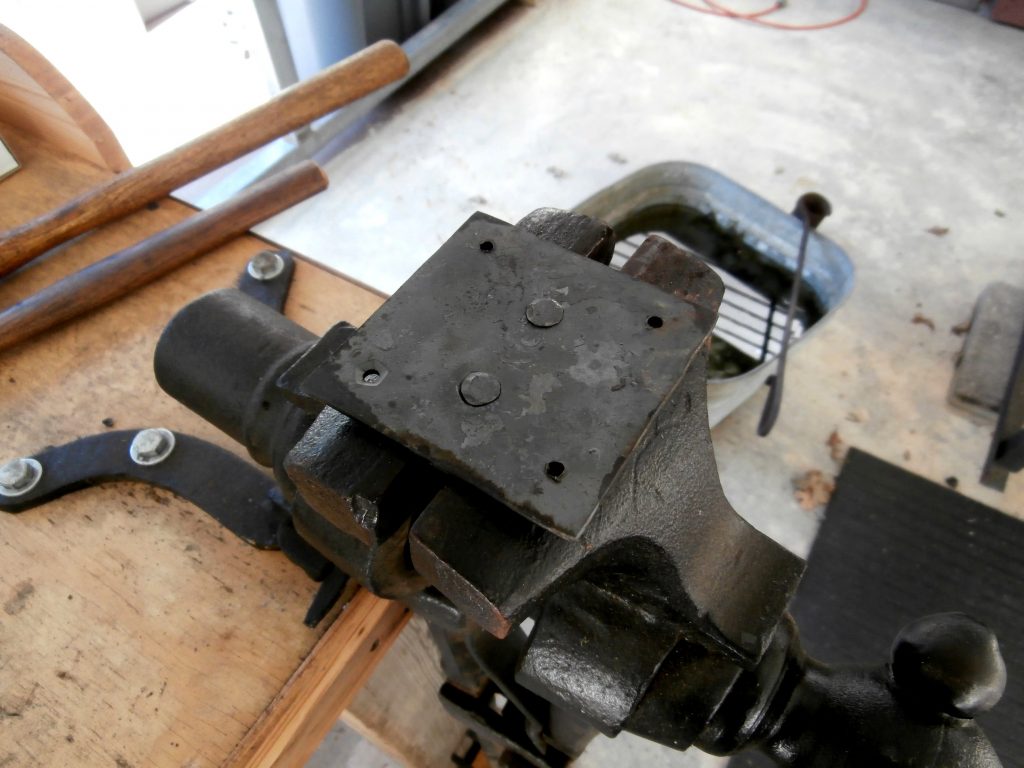
Here is what that part looks like sitting right side up on the anvil.

All that remained was to forge some nails, drill the holes for the nails in the hinges and hasp, heat the parts to a black heat in the forge and coat the parts with Johnson’s Floor Wax while the steel is still hot. This leaves a nice, semi-gloss surface finish that offers some protection from corrosion. Obviously, the next step was to mount the hardware on my chest. The next four photos show the mounted hinges and hasp on my chest as it sits in my living room.
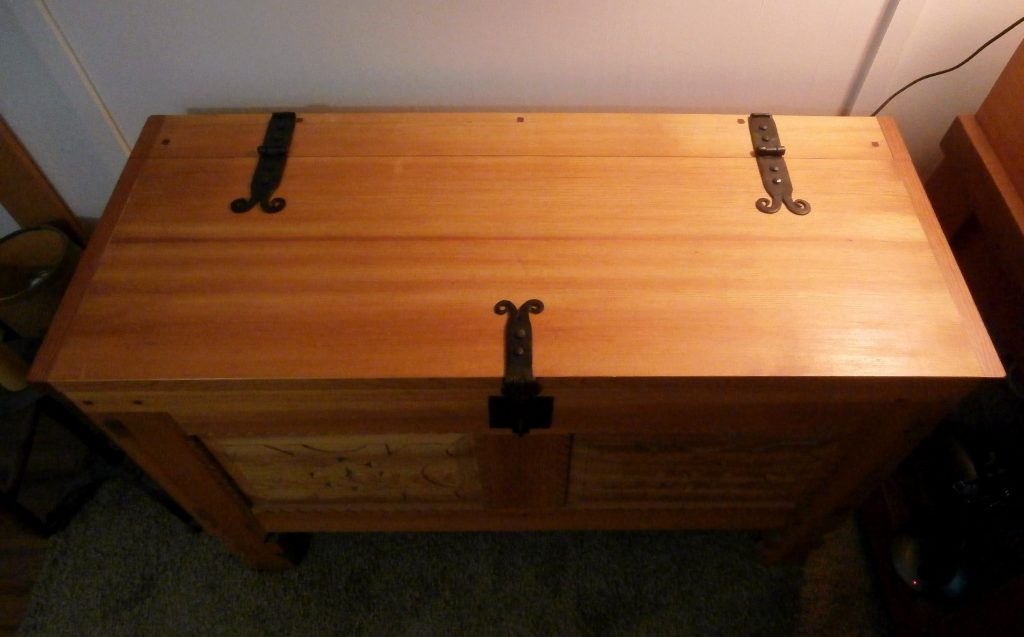
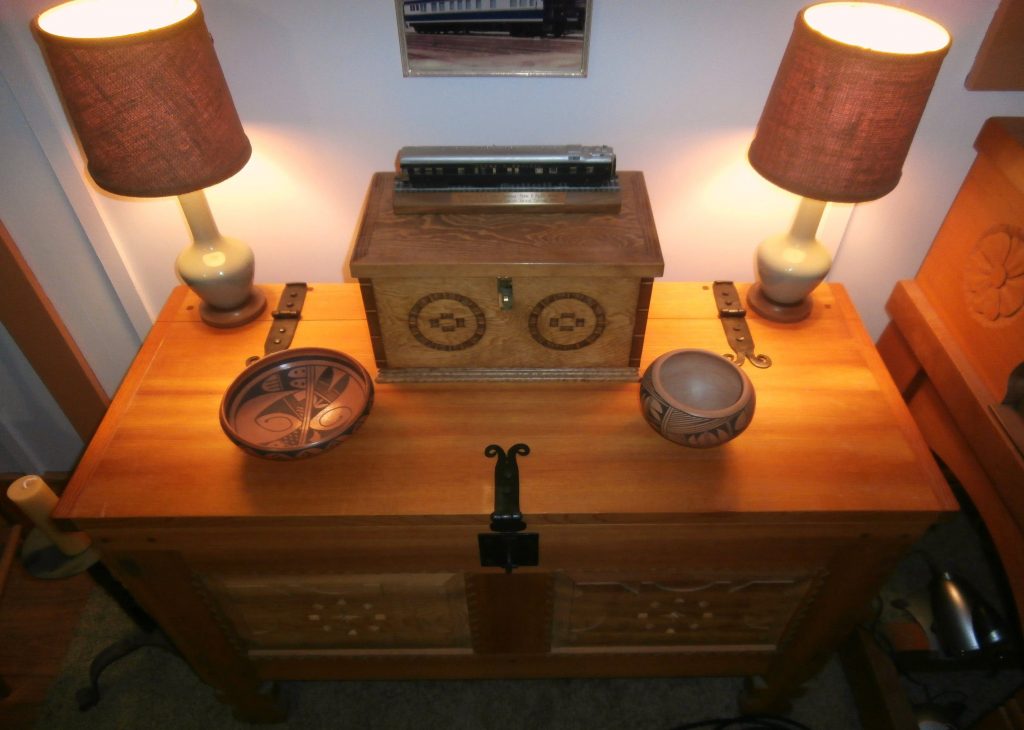
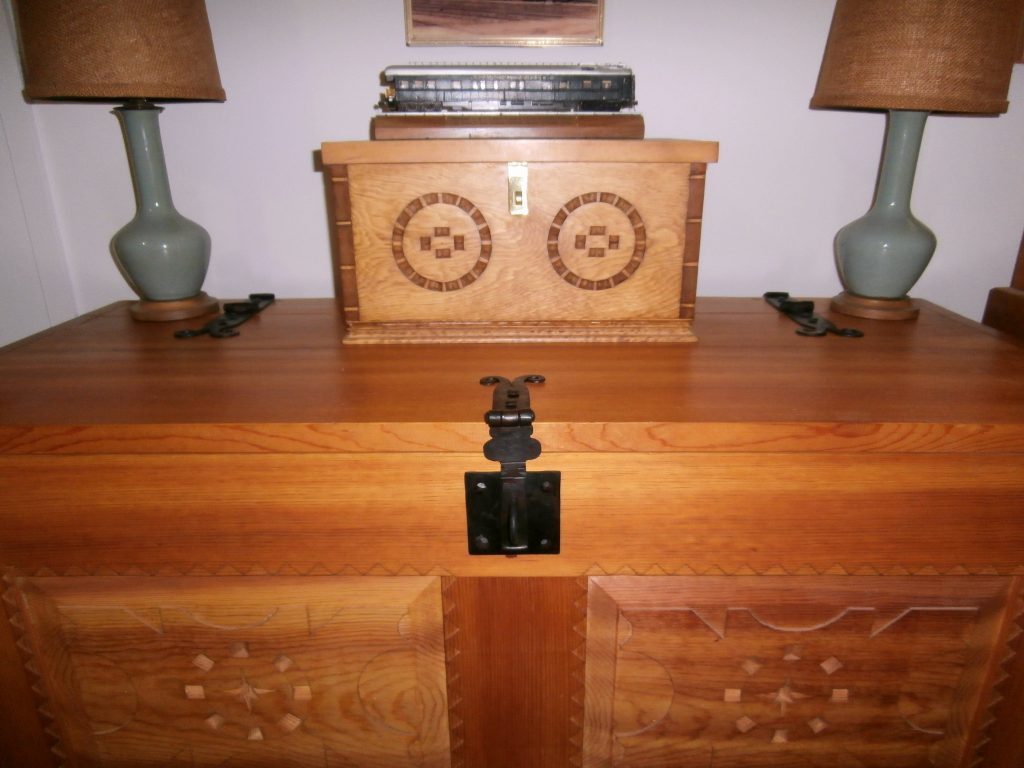
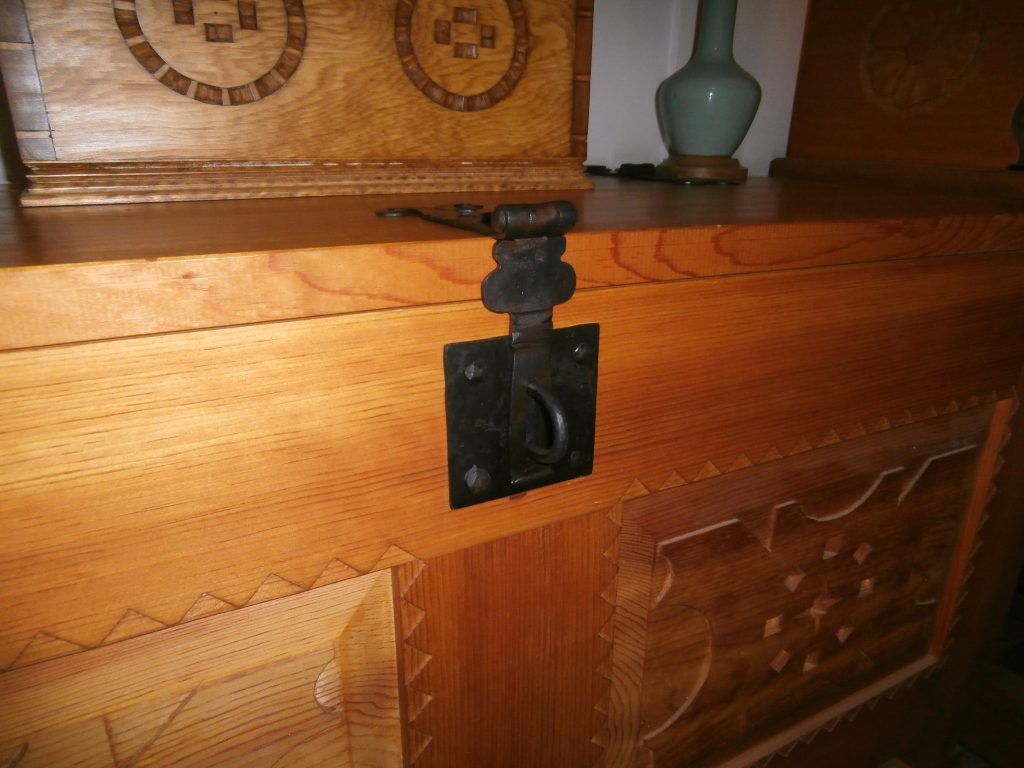
Amateur video, but these sisters are anything but amateurs. Love the music.